IS MATTER AROUND US PURE ? for Class 9 CHEMISTRY
INTRODUCTION
As we know that matter is anything that occupies space, has mass and is made up of constituent particles which have their characteristic properties. Matter is made up different kinds of particles and chemically the nature of these particles could be
(a) Pure Substances
(b) Mixtures
The mixtures are formed when different pure substances mix with each other. For example - While painting, the water in which we clean our brush has different colours in it so it is a mixture of different colours but the red, blue, black paint coloured paints individually are pure substances.
Classification of Matter
Ab jaise ki hume pata h matter wo substance hota h jo space occupies karta h aur iska kuch specific mass hota h. Also, matter unn constituent particles se bana hua hota h jiski characteristics properties hoti h. Ab matter different kinds of particles se bana hua hota h, jisse hum chemically 2 types meh classify karte h:
(a) Pure substances
(b) Mixtures
Yahan mixtures tab bante h jab different pure substances aapas meh mix hote h. For example while painting, jis water meh hum brush ko clean karte h, usme different colours hote h, jis wajah se isko hum mixture of different colours bolte h. Lekin red, blue, black coloured paints individually pure substances hote h.
Pure & Impure Substances

Layman’s term meh pure wo substance hota jo sabhi kind ki impurities se free hota h.
For example 24 Carat Gold ko hum Pure gold bolte h kyunki isme koi b impurities nahi hoti h. Also, pure substance wo substance hota h jisse hum physical aur chemical methods se any other kinds of matter meh separate nahi kar sakte h.
Ab pure substance ko hum Elements aur Compounds meh classify kar sakte h.
Yahan element purest form of atom hoti h jisse hum further smaller components meh divide nahi kar sakte h. For example sodium, nitrogen, calcium, hydrogen etc., overall yahan 118 elements hote h jo ek hi kind ke hote h.
Similarly, jab two or more pure elements ek fixed ratio meh chemically bonded hote h, tab usse hum compound bolte h. For example H2O,CO2,CH4,SO2 etc.,
Ab agar hum impure substance consider kare toh technical terms meh isse hum mixture bolte h. Also, yahan impure ka matlab ye nahi ki isme harmful or bad things involved hoti h, balki impure ka yahan ye matlab h ki isme more than one pure substances (element or compound) or more than one kind of particles present hote h. For example : hamare aas paas jo air present h, wo dikhne meh pure aur clear hoti h, lekin chemically air meh many different gases jaise carbon dioxide (CO2), oxygen (O2), nitrogen (N2), hydrogen (H2) etc., gases present hoti h, jis wajah se ye impure or mixture hoti h.
Ab mixtures ko hum 2 types meh classify kar sakte h Homogeneous aur Heterogeneous
Homogeneous mixtures wo hote h jisme different components uniformly present hote h. For example Tea, sugar/salt solution.
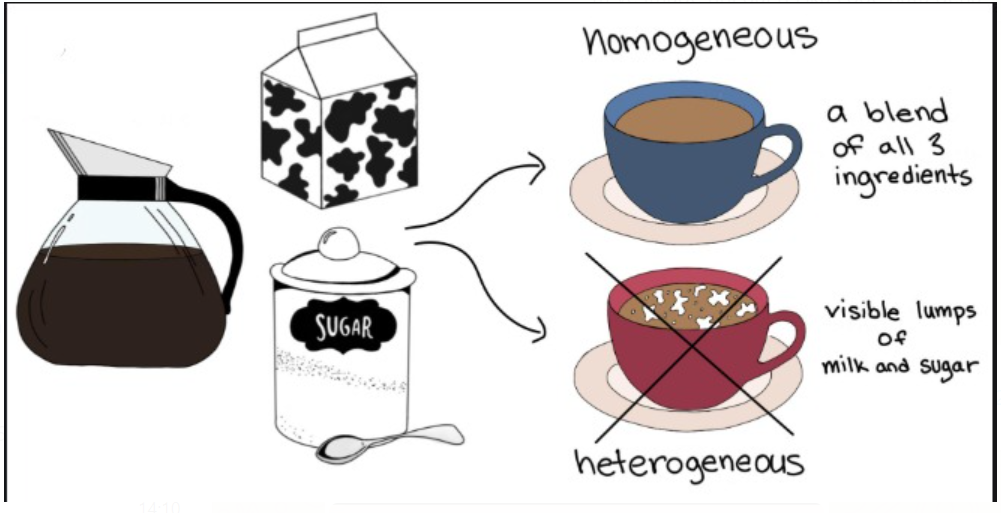
On the other hand, heterogeneous mixtures wo hote h jisme different components uniformly present nahi hote. For example Fruit salad, Namkeen mixture etc.,

Pure & Impure Substances

In Layman's terms pure is anything that is free from any kind of impurities.
For example 24 Carat Gold is known as Pure gold because it does not have any other impurities in it. A pure substance can also be defined as something which cannot be separated into any other kinds of matter by physical or chemical methods.
A pure compound is further divided into Elements and Compounds
Element is the purest form of an atom which cannot be further divided into smaller components. For example : Sodium, Nitrogen, Calcium, Hydrogen e.t.c there are 118 elements which are one of a kind.
Compound is formed when two or more pure elements are bonded chemically in a fixed ratio, For Example : H2O,CO2,CH4,SO2 etc.,
An impure substance in technical terms is known as mixture and by impure it doesn't mean that it has harmful or bad things involved in it, impure term here simply means that there are more than one pure substances (elements or compound) or more than one kind of particles are present. For example : Air present around us looks clear and pure, but chemically it's not as it has many different gases like carbon dioxide (CO2), oxygen (O2), nitrogen (N2), hydrogen (H2) etc., hence it is impure or mixture.
The mixtures is also of two types Homogeneous and Heterogeneous
The homogeneous mixtures are the one in which the different components are present uniformly. For example : Tea, Sugar/Salt solution.

The heterogeneous mixtures are opposite to this and the different types of components are not present uniformly. For example : Fruit salad, Sand, Namkeen mixture etc.

Compound
Compound ko hum further on the basis of their origin 2 types meh classify kar sakte h:
1) Inorganic Compounds - Ye compounds non-living resources jaise rocks, minerals se obtained hote h.
For example common salt, rock salt, marble, washing soda, baking soda, carbon dioxide, ammonia, urea, Sulfuric acid, Hydrochloric acid.
2) Organic Compounds - Ye compounds living resources jaise plants aur animals se obtained hote h aur sabhi organic compound meh carbon main constituent hota h, iss wajah se inn compound ko carbon compounds bolte h.
For example methane, ethane, propane, butane, alcohol, acetic acid
Characteristics of Compounds
(i) Pure compound same elements se bane hue hote h jo fixed ratio by mass meh combined hone par molecules banate h.
(ii) Pure compound nature meh homogeneous hota h aur ye actually ek single substance hota h jo certain elements se banta h.
(iii) Jab elements ke beech chemical reaction hoti h, tab inke beech chemical bond formed hota h (covalent, ionic etc.,). As a result, tab yahan chemical compound formed hota h .
(iv) Chemical compounds ke constituents ko hum mechanically separate nahi kar sakte.
(v) Compounds ke formation aur decomposition ke liye hume energy required hoti h jisse hum heat, light or electricity ki form meh use karte h.
(vi) Also, compound ki properties constituent elements se entirely different hoti h, jisko hum following observation se samaj sakte h.
Jab hum dilute sulfuric acid ko iron sulphide compound se react karte h tab ye hume colourless gas of hydrogen sulphide deta h jiski smell rotten eggs ki tarah hoti h. Iske alawa yahan koi hydrogen gas form nahi hoti jiska matlab iron sulphide meh jo iron present h wo apni properties show nahi karta. Also, iron sulphide meh jo sulphur present h wo b carbon disulfide meh dissolved nahi hota jiska matlab iron sulphide compound sulphur ki properties b show nahi karta h. Hence, hum yahan ye conclude kar sakte h ki iron sulphide compound, individual constituents ki properties show nahi karta i.e., iron aur sulphur.
Compound
Compounds are further divided into two types on the basis of their origin.
1) Inorganic compounds - These compounds are obtained from non living resources such as Rocks and Minerals.
For example: common salt, rock salt, marble, washing soda, baking soda, carbon dioxide, ammonia, urea, Sulfuric acid, Hydrochloric acid.
2) Organic Compounds - Those compounds which are obtained from living beings that are plants and animals. All the organic compounds contain carbon as their main constituent and hence they are also known as carbon compounds.
For Example : Methane, Ethane, Propane, Butane, alcohol, acetic acid.
Characteristics of Compounds
(i) A pure compound is composed of the same elements combined in a fixed ratio by mass to form molecules.
(ii) A pure compound is homogeneous in nature, a pure compound is actually a single substance made up of certain elements.
(iii) A chemical compound is formed when chemical reaction takes place between the elements and a chemical bond is formed (Covalent, Ionic e.t.c).
(iv) Constituents of a chemical compound cannot be separated mechanically.
(v) Formation or decomposition of compounds involves energy that energy can be in the form of heat, light or electricity.
(vi) The properties of a compound are entirely different from those of its constituent elements. We can understand this by the following observation.
When dilute sulfuric acid reacted to the iron sulphide compound we got a colourless smelling gas called hydrogen sulphide which has the smell of rotten eggs and no hydrogen gas was formed which means that iron sulphide does not show the properties of iron present in it. The sulphur present in the iron sulphide also can’t be dissolved in carbon disulfide which means that iron sulphide compound does not show the properties of sulphur too. Hence, we conclude that iron sulphide compound does not show the individual properties of its constituents i.e. Iron and sulphur.
Elements
Element pure substance ki simplest aur most basic form hoti h, jo further smaller forms meh break nahi hoti. According to Dalton’s atomic theory an element has only one kind of atom. Sabhi elements jaise hydrogen, helium, nitrogen, carbon, sodium etc., are pure substances.
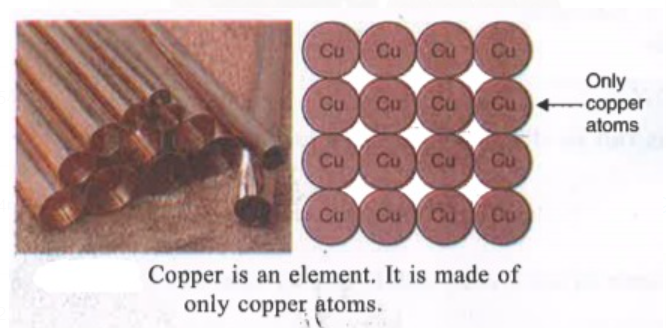
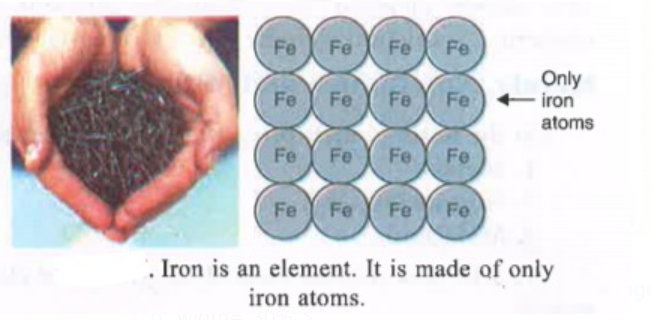
Types of Elements on the Basis of Physical State
(a) Solid Elements: Most of the elements room temperature par solid hote h. For example silver, gold, carbon (Graphite, Diamond) etc.,
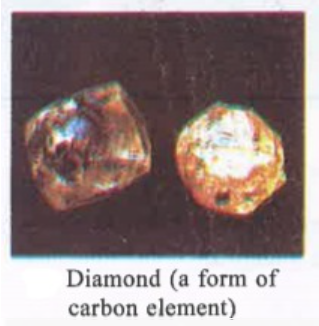
(b) Liquid Elements: Elements jaise mercury, bromine room temperature par liquid hote h aur elements jaise gallium, caesium 302 K temperature par liquid hote h.
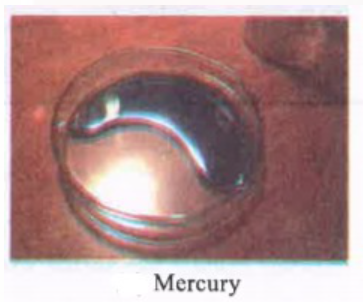
(c) Gaseous Elements: Kuch elements room temperature par gaseous form meh b exist karte h. For example hydrogen, oxygen, nitrogen, fluorine etc.,
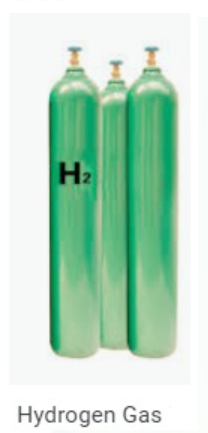
Types of Elements Based on Characteristics
Ye 3 types ke hote h.
(1) Metals:

Overall 92 elements naturally occur hote h, jisme 70 metals hote h.
Metal meh atoms very closely packed hote h aur inme different kind of bond present hote h jisse hum Metallic bond bolte h.
Ab hum metals ki important characteristics properties ko discuss karte h:
(i) Metals are Malleable - Iska matlab metals ko hum hammer se beat karne par thin sheets meh (without breaking) convert kar sakte h. Gold aur silver metals best malleable metals hote h. Moreover, aluminium aur copper metals b highly malleable metals hote h. Malleability ek characteristics properties of metals hoti h jiski many applications hoti h jaise - food wrapping ke liye hum aluminium foil paper use karte h, sweets decoration ke liye hum silver paper use karte h, rockets making ke liye hum gold sheets use karte h, utensils or other containers making ke liye hum copper sheets use karte h.
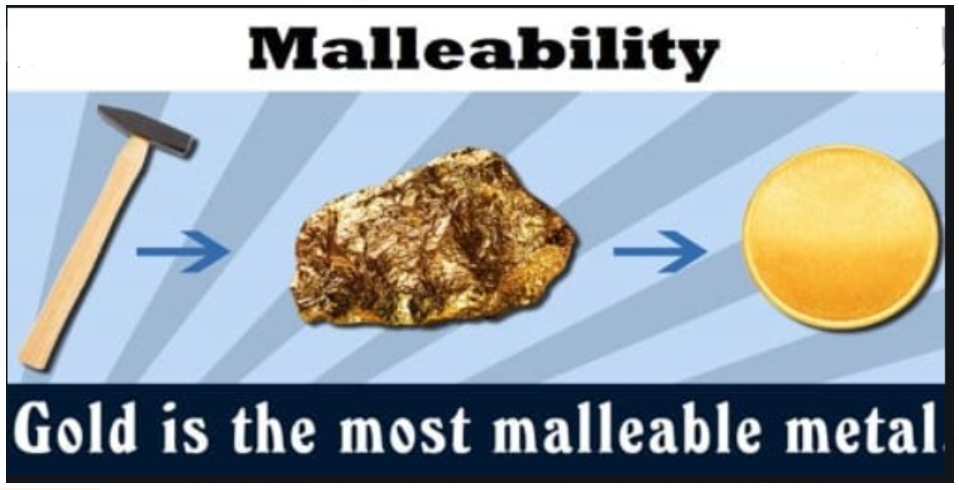

(ii) Metals are Ductile - Iska matlab metals ko hum stretched karne par thin wires meh convert kar sakte h. Ab sabhi metals equally ductile nahi hote. Kuch metals some other metals ke comparison jyada ductile hote h. Gold aur silver best ductile metals hote h.
For example 100 milligrams highly ductile silver metal ko hum stretch karne par about 200 metres long thin wire meh convert kar sakte h. Copper aur aluminum metals b very ductile metals hote h jisse hum electrical wiring ke liye thin wire meh convert kar sakte h. Thus, ductility b ek characteristics property of metals hoti h.

(iii) Metals are Good Conductors of Heat and Electricity - Iska matlab metals se heat aur electricity easily paas ho jati h. Metals generally good conductors of heat hote h, jisse hum thermal conductivity b bolte h. Silver metal best conductor of heat hota h, i.e., iski highest thermal conductivity hoti h. Copper aur aluminium metals b very good conductors of heat hote h. Ab cooking utensils aur water boilers, usually copper or aluminium metals ke bante h, kyunki ye very good conductors of heat hote h. Also metals meh lead aur mercury poorest conductor of heat hote h.
(iv) Metals are Lustrous (or Shiny) and can be Polished - For example, gold, silver, copper shiny metals hote h aur inhe hum polish b kar sakte h. Metals ki property of having shining surface ko hum metallic lustre (chamak) bolte h. Ab metals ki iss shiny appearance ki wajah se isse hum jewellery aur decoration pieces ke liye use karte h. For example gold aur silver ko hum jewellery making ke liye use karte h kyunki ye bright aur shiny hote h. Also, metals ke shiny surface inhe good reflectors of light b banate h, jisme silver metal excellent reflector of light hota h.
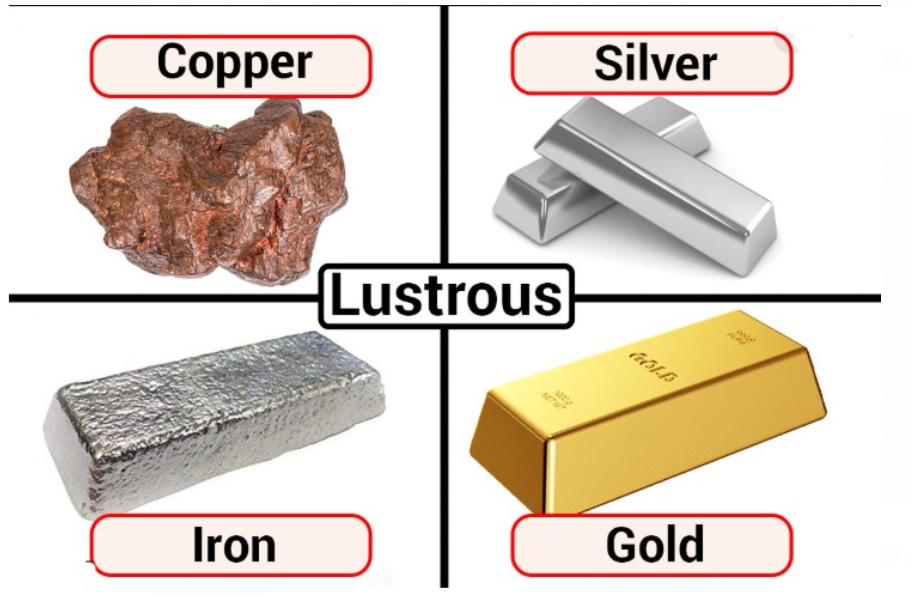
(v) Metals are Generally Hard - Most of the metals hard hote h, kyunki metal meh constituent atoms tightly packed hote h. Lekin sabhi metals equally hard nahi hote, inki hardness metal to metal vary karti h. Metals jaise iron, copper, aluminium etc., very hard hote h, inko hum knife se cut nahi kar sakte. Although inme kuch exceptions b hote h jaise sodium aur potassium soft metals hote h aur inhe hum knife se easily cut kar sakte h.
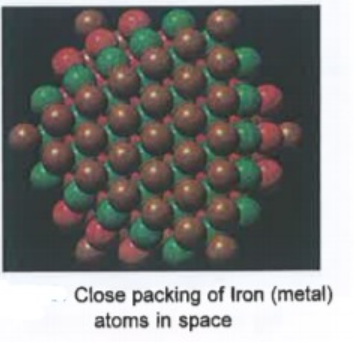
(vi) Metals are Sonorous - Jab metals ko hit or bent kiya jata h tab ye sound produce karte h. For example temple bell, silver or copper utensils etc.,
(2) Non-Metals:
Non-metals ki properties metals ke comparison opposite hoti h.
(i) Non-metals room temperature par solid or liquids dono hote h, isme bromine exception hota h jo sirf liquid hota h.
(ii) Non-metals poor conductor of heat or electricity hote h.
(iii) Most of the non-metals soft hote h aur inki density metals se less hoti h. Except diamond jo very hardest substance known h.
(iv) Non-metals generally non-malleable aur non-ductile in nature hote h.
(v) Non-metals sonorous b nahi hote aur inka low melting aur boiling point hota h.
(3) Metalloids or Semimetals
Ye wo elements hote h jo metals or non-metals dono ki properties show nahi karte, metalloids ki properties in between metals or non-metals hoti h iss wajah se inhe hum semimetal or metalloid bolte h. For example silicon, arsenic, antimony.
Elements
Elements is the simplest and most basic form of pure substance which cannot be further broken into smaller forms. According to Dalton’s Atomic Theory an element has only one kind of atom. All the elements such as Hydrogen, Helium, Nitrogen, Carbon, Sodium etc are pure substances.


Types of Elements on the basis of Physical State
(a) Solid Elements: Most of the elements are solid at room temperature. For e.g - Silver, Gold, Carbon (Graphite, Diamond) etc.

(b) Liquid Elements: Elements like Mercury, Bromine are liquid at room temperature. Gallium, Caesium, are liquid at 302K temperature.

(c) Gaseous Elements: There are certain elements which are gas at room temperature such as Hydrogen, Oxygen, Nitrogen, Fluorine etc.

Types of Elements Based on Characteristics
They are of three types
(1) Metals:

There are 92 naturally occurring elements out of which 70 belong to metals.
In Metal the atoms are very closely packed and have a different kind of bond known as Metallic bond.
Important characteristics of metals are given below :
(i) Metals are Malleable - This means that metals can be beaten into thin sheets with a hammer (without breaking). Gold and silver metals are some of the best malleable metals, Aluminium and copper metals are also highly malleable metals. Malleability is an important characteristic property of metals as it has many applications such as : The aluminium foil paper used to wrap food, the silver paper used for decoration on sweets, the gold sheets used in making rockets, copper sheets are used to make utensils and other containers.


(ii) Metals are Ductile - This means that metals can be drawn (or stretched) into thin wires. All the metals are not equally ductile. Some are more ductile than the others. Gold and silver are among the best ductile metals.
For example 100 milligrams of a highly ductile metal like silver can be drawn into a thin wire about 200 metres long. Copper and aluminium metals are also very ductile and can be drawn into thin wires which are used in electrical wiring. Thus, ductility is another important characteristic property of metals.

(iii) Metals are Good Conductors of Heat and Electricity - This means that metals allow heat and electricity to pass through them easily. Metals are generally good conductors of heat (The conduction of heat is also called thermal conductivity). Silver metal is the best conductor of heat, i.e. it has the highest thermal conductivity. Copper and aluminium metals are also very good conductors of heat. The cooking utensils and water boilers, etc. are usually made of copper or aluminium metals because they are very good conductors of heat. The poorest conductor of heat among the metals are lead and mercury.
(iv) Metals are Lustrous (or Shiny) and can be Polished - For example, gold, silver and copper are shiny metals and they can be polished, the property of a metal having a shining surface is called metallic lustre (chamak). The shiny appearance of metals makes them useful in making jewellery and decoration pieces. For example, gold and silver are used for making jewellery because they are bright and shiny. The shiny surface of metals makes them good reflectors of light, silver metal is an excellent reflector of light.

(v) Metals are Generally Hard - Most of the metals are hard because in a metal the constituent atoms are tightly packed, but all the metals are not equally hard. The hardness varies from metal to metal. Most of the metals like iron, copper, aluminium, etc. are very hard. They cannot be cut with a knife. There are some exceptions such as : Sodium and potassium are soft metals which can be easily cut with a knife.

(vi) Metals are Sonorous - They produce a sound when bent or hit. For Example the temple bell, Silver or copper utensils, etc
(2) Non-Metals:
Non metals have opposite properties to that of metals.
(i) Non - metals are either solids or liquids at room temperature, bromine is an exception which is a liquid.
(ii) Non- metals are poor conductors of heat and electricity.
(iii) Most of the non-metals are quiet soft and have less density than metals. Diamond being an exception is very hard and is probably the hardest substance known.
(iv) Non-metals are non-malleable and non-ductile in nature.
(v) Non metals are also not sonorous and have low boiling and melting points.
(3) Metalloids or Semimetals
There are elements which do not have properties neither of metal nor of non metals completely, their properties lie in between them hence they are known as metalloids or semimetal. For example - Silicon, Arsenic, Antimony.
Hello Points!
Differences between Elements and Compounds

EXAMPLE 1
How will you justify that water is a compound ?
Water is considered to be a compound due to the following reasons :
(i) Water cannot be separated into its constituents hydrogen and oxygen by physical methods.
(ii) Properties of water are entirely different from its constituents hydrogen and oxygen. Hydrogen is combustible while oxygen supports combustion. Water is quite different from the two and it extinguishes fire.
(iii) Heat and light are given out when water is formed by burning hydrogen and oxygen.
(iv) The composition of water is fixed. Its constituents hydrogen and oxygen are present in the ratio of 1 : 8 by mass.
(v) Water has a fixed boiling point of 100∘C (or 373 K) under atmospheric pressure of one atmosphere (or 760 mm).
EXAMPLE 2
Classify the following as pure substances or mixtures. Separate the pure substances into elements, compounds and divide the mixtures into homogeneous and heterogeneous :
(i) Clean Air (ii) Milk (iii) Graphite (iv) Gasoline (v) Diamond (vi) Tap water (vii) Distilled water (viii) Oxygen (ix) Brass (x) 22 Carat gold (xi) Steel (xii) Iron (xiii) Sodium chloride (xiv) Iodised table salt.
(i) Clean Air : Mixture (Homogeneous)
(ii) Milk : Mixture (Homogeneous)
(iii) Graphite : Pure substance (Element)
(iv) Gasoline : Mixture (Homogeneous)
(v) Diamond : Pure substance (Element)
(vi) Tap water : Mixture (Homogeneous)
(vii) Distilled water : Pure substance (Compound)
(viii) Oxygen : Pure substance (Element)
(ix) Brass : Mixture (Homogeneous)
(x) 22 Carat gold : Mixture (Homogeneous)
(xi) Steel : Mixture (Homogeneous)
(xii) Iron : Pure substance (Element)
(xiii) Sodium chloride : Pure substance (Compound)
(xiv) Iodized table salt : Mixture (Heterogeneous)
EXAMPLE 3
A group of materials 'P' can be subdivided into three groups 'Q', 'R' and 'S' as the basis of their characteristics The substance belonging to group 'Q' may be solid, liquids and gases. These are poor conductors of electricity. The substances included in group 'R' are solids which are good conductors of electricity. Group 'S' consists of substances which have the characteristics common to the substances belonging to groups 'Q' and 'R'.
Based upon the above observations, answer the following questions :
(a) To which class of substances materials present in group 'P' belong ?
(b) Name the type of substances 'Q'. Give two examples.
(c ) Name the type of substances 'R'. Give two examples.
(d) Name the type of substances 'S'. Give two examples.
(a) Materials present in group 'P' are known as elements.
(b) The substances 'Q' which are poor conductors of electricity and exist in all the three states of matter, are non-metals. Example carbon, suphur etc.,
(c) The substances 'R' are metals since they are good conductors of electricity. Example aluminium, copper etc.,
(d) The substances 'S' are metalloids or semimetals since they have characteristics common to both 'P' and 'Q'. Example silicon, germanium
EXAMPLE 4
(a) Name a non-metallic element found in (i) liquid state (ii) gaseous state.
(b) Pick metalloid from the elements carbon, silicon, phosphorus, gold.
(c) Which two properties of metals enable us to give the desired shapes to metals ?
(a) (i) Bromine (Br2) (ii) Oxygen (O2)
(b) Silicon is a metalloid.
(c) Metals are malleable and ductile. i.e., they can be beaten into sheets and drawn into wires.
Mixtures
Types of mixtures
Mixtures 2 types ke hote h:
1. Homogeneous Mixtures
2. Heterogeneous Mixtures
1. Homogeneous Mixtures - Jin mixtures meh substances completely mixed ho jate h aur unhe hum ek dusre se distinguish nahi kar pate h, unn mixtures ko hum homogeneous mixtures bolte h.
Homogeneous mixture meh mass ki uniform composition hoti h aur isme various constituents ke beech koi visible boundaries of separation nahi hoti h. For example a mixture of salt in water (salt solution) homogeneous mixture h kyunki salt solution ke sabhi parts ki same salt water composition hoti h aur ye equally salty appear hote h.
Yahan salt aur water particles ke salt solution meh koi visible boundary nahi hoti h. Also, jis mixture meh 2 or more miscible liquids hote h, wo b homogeneous mixture hota h.
For example mixture of alcohol aur water homogeneous mixture hota h. Air b ek homogeneous mixture of gases h jisme oxygen, nitrogen, argon, carbon dioxide aur water vapour etc., present h.
Homogeneous mixtures ko hum solutions b bolte h. Some of the examples of homogeneous mixtures (or solutions) are : sugar solution, salt solution, copper sulphate solution, sea-water, alcohol aur water mixture, petrol aur oil mixture, soda water, soft drinks, lemonade, vinegar, brass, air, kerosene oil aur petrol.

2. Heterogeneous Mixtures - Jin mixtures meh substances separate rahte h aur ek substance dusre substance ke aas paas small particles, droplets or bubbles ki form meh spreaded rahte h unhe hum heterogeneous mixtures bolte h.
Ab heterogeneous mixture meh mass ki uniform composition nahi hoti aur isme various constituents ke beech visible boundaries of separation hoti h.
Mixture of sugar aur sand heterogeneous mixture hota h kyunki iss mixture ke different parts meh sugar aur sand ki different composition hoti h.
Iss mixture ke kuch parts meh sugar particles jyada h aur kuch parts meh sand particles jyada h aur yahan sugar aur sand particles ke beech visible boundary of separation b h.
Suspension of solids in liquids b heterogeneous mixture hota h aur iske alawa mixture of two immiscible liquids b heterogeneous mixture hota h.
Some of the examples of Heterogeneous mixtures are : Sugar and sand mixture, Salt and sand mixture, Polluted air, Gunpowder, Milk, Ink, Petroleum, Paint, Glass, Coal, Soil, Wood, Blood, Starch solution, Soap solution, Iron filings and sulphur Mixture, Dyes, Petrol and water mixture, Chalk and water mixture, Muddy river water, Flour in water, Milk of Magnesia, Butter, Cheese, Face cream, Shaving cream, Hair spray, Fog and Mist.
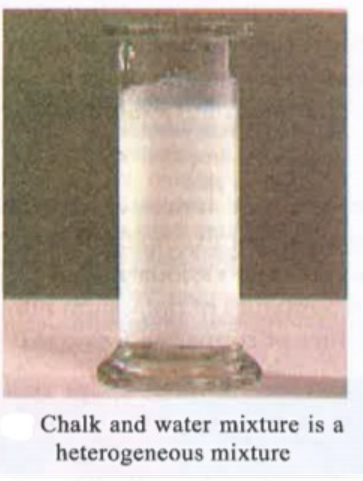
Ab hum concept ko samjhane ke liye ek activity study karte h:
(i) Sabse pehle hum ek magnet ko mixture of iron filings aur sulphur meh rakhte h, jisme iron particles ko magnet attract karti h, so ye magnet se stick hone ke sath sulphur se separated ho jate h.
Since magnet sulphur ko attract nahi karti h iss wajah se ye piche rah jata h.
Thus, mixture of iron filings aur sulphur ko hum inke constituents meh physical method of using magnet se separate kar sakte h.
Alternatively, jab hum mixture of iron filings aur sulphur ko organic liquid known as carbon disulphide (CS2) meh mix karte h tab sulphur isme dissolve ho jata h lekin iron nahi hota h.
Ab jab hum isko filter karte h, tab iron hume residue meh milta h aur sulphur ko hum by evaporating carbon disulphide se recover kar sakte h . Thus, mixture of iron filings aur sulphur ko hum another physical method of using carbon sulphide as solvent se b separate kar sakte h (followed by filtration aur evaporation).
Inn dono experiments se hum ye conclude kar sakte h ki ek mixture ko hum inke constituents meh physical processes (jaise filtration, evaporation, sublimation, distillation, solvents, magnet etc.,) se separate kar sakte h.
(ii) Iske alawa jab hum dilute sulphuric acid ko mixture of iron filings aur sulphur meh add karte h, tab iska iron part sulphuric acid ke sath react karne par hydrogen gas produce karta h (jo colourless aur odourless gas hoti h). Isme sulphur unchanged rahta h.
This shows dilute sulphuric acid ke sath mixture of iron aur sulphur meh sirf iron apni properties show karta h. Ab agar hum mixture of iron aur sulphur ko carbon disulphide ke sath treat kare, tab mixture ka sulphur part CS2 meh dissolve ho jata h aur iron unchanged rah jata h. Iska matlab mixture of iron filings aur sulphur, ab sulphur ki properties b show karta h.
Ab agar hum inn dono results ko combine kare, tab hum ye kah sakte h ki mixture of iron filings aur sulphur dono constituents ki properties show karta h. In general, hum kah sakte h ki ek mixture sabhi constituents ki properties show karta h.
(iii) Jab hum iron filings aur sulphur powder ko mixture banane ke liye mix karte h, tab heat na hi evolved hoti h aur na hi absorbed. In general, mixture banane ke liye energy in the form of heat, light etc., ki form meh na hi evolved hoti h aur na hi absorbed hoti h. So mixing ek physical change h.
(iv) Also, mixture ki different compositions ko obtained karne ke liye hum any amount of iron filings aur sulphur powder ko mix karte h. Thus, mixture of iron filings aur sulphur ki variable composition hoti h. Ab kyunki iski composition variable hoti h iss wajah se mixture of iron filings aur sulphur ka koi definite formula nahi hota h. Iss discussion se hum ye conclude kar sakte h ki mixture ki composition variable hoti h, jis wajah se isme constituents kisi b proportion by mass meh present hote h.
(v) Mixture of iron filings aur sulphur ek single fixed temperature par melt nahi karta h. Iss se hum ye conclude kar sakte h ki mixture ka koi definite melting aur boiling point nahi hota h.
(vi) Also, agar hum mixture of iron filings aur sulphur powder ko magnifying glass se examine kare, then we found that though iron particles aur sulphur particles ek dusre ke close hote h. Lekin kuch places par more iron particles aur kuch places par more sulphur particles hote h. Iska matlab mixture of iron filings aur sulphur heterogeneous hota h, instead of homogeneous. Though most of the mixtures heterogeneous hote h, lekin mixtures jaise solutions aur alloys however, homogeneous hote h.
Yahan se hum ye conclude kar sakte h ki ek mixture usually heterogeneous hota h (except solutions aur alloys jo homogeneous mixtures hote h).
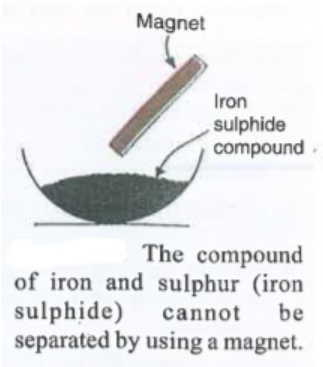
Note: Though ek compound hamesha homogeneous hota h, ek mixture heterogeneous or homogeneous dono hota h. Accordingly nature of the substance ko hum easily determine nahi kar sakte h.
Ab different substances ko differentiate karne ke liye hum following points mind meh rakhte h:
(i) Agar hum kisi substance ko physical method ki help se separate kar pate h, tab wo mixture hota h otherwise wo compound hota h.
(ii) Agar koi substance different constituents ki properties or characteristics show kar pata h, tab wo mixture hota h. Lekin agar substance entirely different properties from the constituents show karta h, tab wo compound hota h.
(iii) Ab agar kisi substance ki preparation meh koi heat or light absorbed or evolved nahi hoti h, tab wo mixture hota h. Similarly agar ye heat or light released or evolved karta h, tab ye compound hota h.
(iv) Ab agar kisi substance ka fixed melting aur boiling point hota h, tab wo compound hota h. Similarly, agar substance ka fixed melting aur boiling point nahi hota, tab wo mixture hota h.
(A) The Case of Solutions
Solutions homogeneous substances hote h aur jab hum solution ki preparation karte h tab ye heat usually evolved or absorbed karta h, even though solution ko hum mixture consider karte h kyunki:
(1) Solution ko hum inke components meh physical methods se separate kar sakte h, jo mixtures ka feature hota h.
(2) Solution constituents ki properties b show karta h.
(3) Solution ki variable composition hoti h.
(4) Solution ka fixed boiling point aur melting point nahi hota h.
For example Salt solution ko following reasons ki wajah se mixture samjha jata h:
(i) Salt solution ko hum physical method distillation se salt aur water meh separate kar sakte h.
(ii) Salt solution dono constituents salt aur water ki properties show karta h.
(iii) Salt solution ki composition variable hoti h.
Different amounts of salt ko hum same amount of water meh dissolve karne par different composition ka salt solution obtained kar sakte h. Iss salt solution ka definite formula nahi hota, matlab jab hum 2 grams of salt ko 1 litre water meh dissolved karte h tab ye salt solution hota h aur jab hum 20 grams of salt ko b 1 litre water meh dissolved karte h, tab b isko hum salt solution bolte h.
Ab agar hume pure compound aur solution ko distinguish karna ho tab hum dono ko separaterly evaporation technique se distinguish kar sakte h. Isme jo liquid completely evaporate ho jata h leaving no residue usse hum pure compound bolte h. On the other hand, jo liquid evaporation par residue piche chodta h usse hum solution or mixture bolte h.
For example pure water ko hum salt solution se by evaporation process distinguish kar sakte h. Iske liye jab hum pure water ko boil karte h tab ye completely evaporate hone ke sath water vapours meh convert ho jata h. Lekin jab hum seawater ko evaporate karte h jisme salt hota h, tab iska water evaporate ho jata h aur salt as residue meh rah jata h.
(B) The Case of Alloys
Alloys different metals ke homogeneous mixture hote h, jisko hum physical method se different components meh separate nahi kar sakte h. Fir b alloy ko hum mixture consider karte h kyunki:
(i) Alloy constituent elements ki properties show karta h.
(ii) Alloy ki variable composition hoti h.
For example Brass homogeneous substance hota h or alloy of copper and zinc metal Brass hota h. Isko hum physical method se constituents elements meh separate nahi kar sakte h. Ab hum brass ko mixture consider karte h kyunki ye copper aur zinc dono ki properties show karta h aur iski variable composition hoti h matlab brass meh zinc ka amount 20 to 35 % differ karta h.
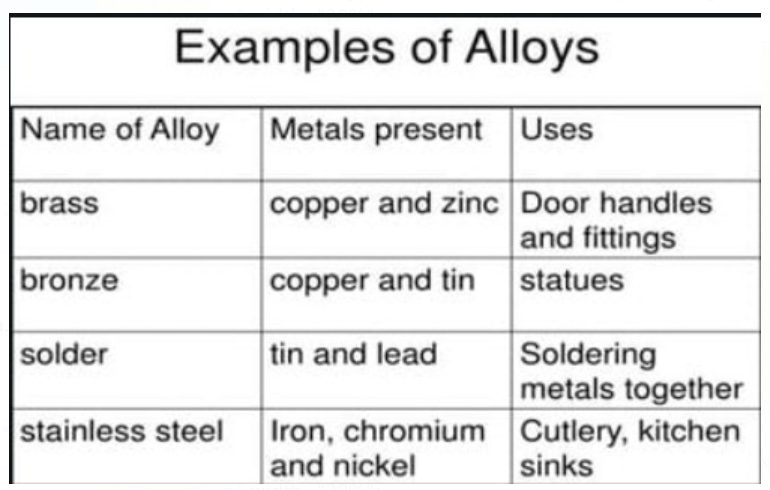

Mixtures
Types of Mixtures
Mixtures are of two types :
1. Homogeneous Mixtures
2. Heterogeneous Mixtures
1. Homogeneous Mixtures - Those mixtures in which the substances are completely mixed together and are indistinguishable from one another are called homogeneous mixtures.
A homogeneous mixture has a uniform composition throughout its mass and has no visible boundaries of separation between the various constituents. A mixture of salt in water (called salt solution) is a homogeneous mixture because all the parts of salt solution have the same salt-water composition and appear to be equally salty.
There is no visible boundary of separation between salt, and water particles in a salt solution. A mixture of two (or more) miscible liquids is also a homogeneous mixture.
For example a mixture of alcohol and water is a homogeneous mixture. Air is a homogeneous mixture of gases like oxygen, nitrogen, argon, carbon dioxide and water-vapour, etc.
Homogeneous mixtures are also called solutions. Some of the examples of homogeneous mixtures (or solutions) are : Sugar solution, Salt solution, Copper sulphate solution, Sea-water, Alcohol and water mixture, Petrol and oil mixture, Soda water, Soft drinks, Lemonade, Vinegar, Brass, Air, Kerosene oil, and Petrol.

2. Heterogeneous Mixtures - Those mixtures in which the substances remain separate and one substance is spread throughout the other substance as small particles, droplets or bubbles, are called heterogeneous mixtures.
A heterogeneous mixture does not have a uniform composition throughout its mass, and a visible boundaries of separation is present between the various constituents.
The mixture of sugar and sand is a heterogeneous mixture because different parts of this mixture will have different sugar-sand compositions.
Some parts of this mixture will have more of sugar particles whereas other parts will have more of sand particles, there is a visible boundary of separation between sugar and sand particles.
The suspensions of solids in liquids are also heterogeneous mixture and along with this a mixture of two immiscible liquids is also a heterogeneous mixture.
Some of the examples of Heterogeneous mixtures are : Sugar and sand mixture, Salt and sand mixture, Polluted air, Gunpowder, Milk, Ink, Petroleum, Paint, Glass, Coal, Soil, Wood, Blood, Starch solution, Soap solution, Iron filings and sulphur Mixture, Dyes, Petrol and water mixture, Chalk and water mixture, Muddy river water, Flour in water, Milk of Magnesia, Butter, Cheese, Face cream, Shaving cream, Hair spray, Fog and Mist.

Let us study the following activity to understand the concept:
(i) If we put a magnet in the mixture of iron filings and sulphur, the iron particles are attracted by the magnet, they stick to the magnet and get separated from sulphur.
Sulphur is not attracted by the magnet, so it is left behind.
Thus, a mixture of iron filings and sulphur has been separated into its constituents, iron and sulphur, by the physical method of using a magnet.
Alternatively, if we mix the mixture of iron filings and sulphur with : an organic liquid known as carbon disulphide (CS2), then sulphur dissolves in it but iron does not dissolve.
On filtration, iron is obtained as a residue and sulphur is recovered from the filtrate by evaporating carbon disulphide. Thus, a mixture of iron filings and sulphur has been separated by another physical method of using carbon disulphide as a solvent (followed by filtration and evaporation). From these two experiments we conclude that a mixture can be separated into its constituents by physical processes (like filtration, evaporation, sublimation, distillation, solvents, magnet, etc.).
(ii) If dilute sulphuric acid is added to the mixture of iron filings and sulphur, the iron part reacts with sulphuric acid and hydrogen gas is produced (which is a colourless and odourless gas). Sulphur remains unchanged.
This shows that a mixture of iron and sulphur shows the properties of iron, now if this mixture of iron and sulphur is treated with carbon disulphide, the sulphur part dissolves in it leaving the iron unchanged.
This means that a mixture of iron filings and sulphur also shows the properties of sulphur. If we combine these two results, we can say that a mixture of iron filings and sulphur shows the properties of both its constituents which are iron as well as sulphur. In general we can say that a mixture shows the properties of all the constituents present in it.
(iii) When iron filings are mixed with sulphur powder to prepare the mixture, heat is neither evolved or absorbed. In general, energy (in the form of heat, light, etc.) is usually neither given out nor absorbed in the preparation of a mixture. So, mixing is a physical change.
(iv) We can mix any amount of iron filings and sulphur powder to get mixtures having different compositions. Thus, a mixture of iron filings and sulphur has a variable composition. Since its composition is variable, no definite formula can be given to a mixture of iron filings and sulphur. From this discussion we conclude that the composition of a mixture is variable, the constituents can be present in any proportion by mass.
(v) A mixture of iron filings and sulphur does not melt at a single fixed temperature. From this we conclude that a mixture does not have a definite melting point, boiling point, etc.
(vi) If we examine the mixture of iron filings and sulphur powder with a magnifying glass, it is found that though the iron particles are quite close to the sulphur particles, but at some places there are more of iron particles whereas at other places there are more of sulphur particles. That is, a mixture of iron filings and sulphur is not homogeneous, it is heterogeneous. Though most of the mixtures are heterogeneous, some of the mixtures called solutions and alloys are, however, homogeneous.
From this we conclude that a mixture is usually heterogeneous (except solutions and alloys which are homogeneous mixtures).

Note: Though a compound is always homogeneous, a mixture may be heterogeneous or homogeneous. So one cannot determine the nature of a substance easily.
So here are some points to keep in mind to differentiate:
(i) If you're able to separate the substance with the help of a physical method then it is a mixture and if not then it is a compound.
(ii) If a substance shows the properties or characteristics of the constituents then it is a mixture, but if the properties are entirely different from those of its constituents then it is a compound.
(iii) During the preparation of the substance if no heat or light is given out or absorbed then it is a mixture and if heat and light are given out then it is a compound.
(iv) If the substance has a fixed melting point, boiling point then it is a compound and if it does not have a fixed melting point and boiling point then it is a mixture
(A) The Case of Solutions
Solutions are homogeneous substances and heat is usually evolved or absorbed in the preparation of a solution even then a solution is considered to be a mixture because :
(1) It can be separated into its components by physical methods which is a feature of mixtures.
(2) It shows the properties of its constituents.
(3) It has a variable composition.
(4) It does not have a fixed boiling point and melting point.
For example Salt solution is considered a mixture because of the following reasons :
(i) Salt solution can be separated into salt and water by the physical method of distillation.
(ii) Salt solution shows the property of both of its constituents that is salt and water.
(iii) The composition of salt solution is variable.
Different Amount of salt can be dissolved in the same amount of water to get salt solution having different composition. The salt solution does not have a definite formula that is if we dissolve 2 grams of salt in 1 litre of water it is a salt solution and if we dissolve 20 gram of salt in 1 litre of water then also it is a salt solution.
If we have to distinguish between a pure compound and a solution we should evaporate them separately. The liquid which evaporate completely leaving no residue is a pure compound on the other hand the liquid which leaves behind a residue on evaporation is a solution or mixture.
For example Pure water can be distinguished from the salt solution by evaporation, if we boil pure water it evaporate completely and the pure water converts into water vapours, but if we try to evaporate seawater which contains salt in it then the water goes away but salt is left behind.
(B) The Case of Alloys
Alloys are homogeneous mixture of metals and they cannot be separated into their separate components by physical methods. Even then an alloy is considered a mixture because:
(i) It shows the properties of its constituent elements.
(ii) It has a variable composition.
For example Brass is a homogeneous substance which is composed of Copper and Zinc. It cannot be separated into its constituents by physical method. Brass is considered a mixture because it shows the properties of Copper and Zinc and it has a variable composition that is the amount of zinc in brass can vary from 20 to 35%.


Hello Points!
Differences between Mixture and Compounds
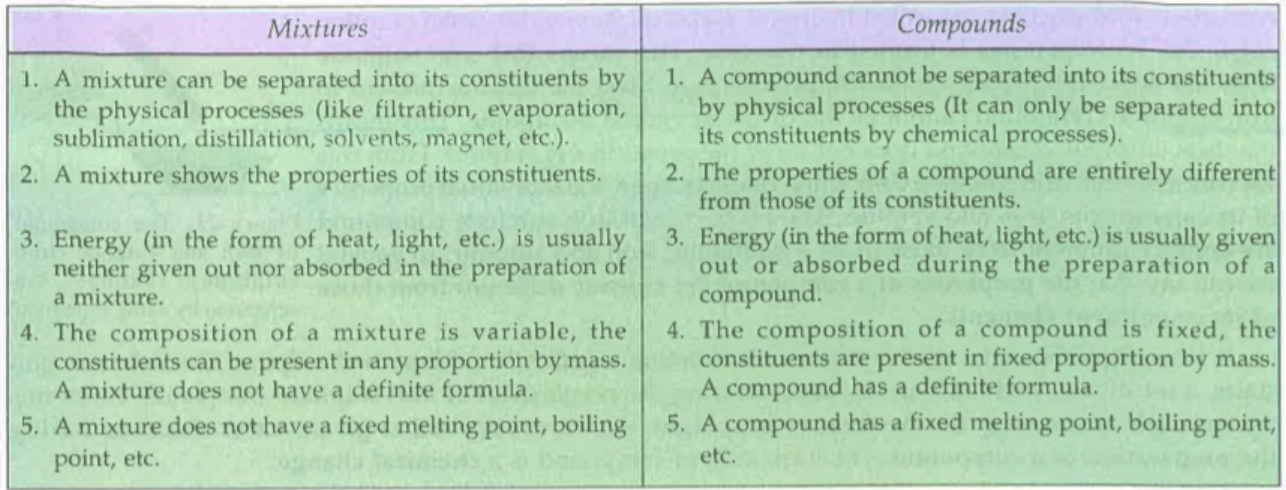

Solutions
Ab homogeneous mixture meh humne padha tha ki solution ek homogeneous mixture of two or more substances hota h. Ek homogeneous mixture wo mixture hota h jo throughout the mixture same rahta h.
Although solution meh any number of components hote h lekin jis solution meh 2 components hote h i.e., Solute aur Solvent such solutions ko hum binary solutions bolte h.
Isme solute component less quantity aur solvent component larger quantity meh hota h. Common examples of solutions are : salt solution, sugar solution, vinegar, metal alloys (such as Brass) aur air.
Salt solution homogeneous mixture of two substances hota h jaise salt aur water, whereas sugar solution b ek homogeneous mixture of two or more substances hota h jaise sugar aur water. Salt solution aur sugar solution ko hum true solution b bolte h kyunki inn solutions meh particles of salt aur sugar, water meh iss tarah mixed hote h ki hum particles ko ek dusre se distinguish nahi kar paate.
For example jab hum lemonade banate h tab hum lemon juice aur sugar dono ko mix karte h. Isme lemon juice aur sugar solute hote h whereas water jo large quantity meh hota h wo yahan solvent hota h. Ab after mixing hum ye nahi bata sakte h ki lemonade ke kis part meh lemon jucie h aur kis part meh sugar, hence ye ek true solution h.
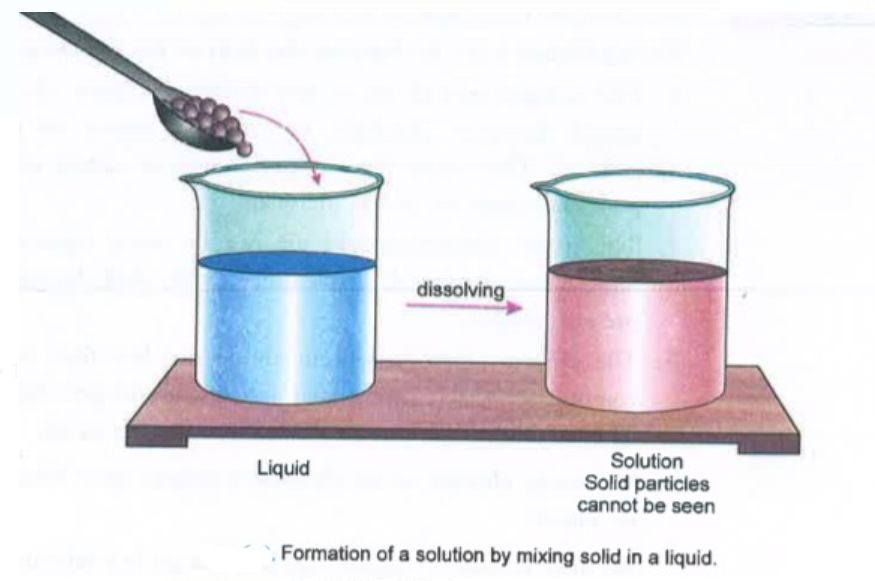
Types of Solutions
Ab binary solution meh solute aur solvent, solid, liquid or gas meh se kisi b form meh ho sakte h. Lekin on the basis of nature of the solvent hum solutions ko 3 types meh classify kar sakte h.
(i) Solid Solutions : Iss solution meh solid solvent ki tarah act karta h.
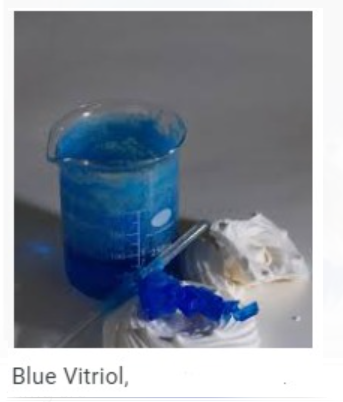
(ii) Liquid Solutions : Iss solution meh liquid solvent ki tarah act karta h.
(iii) Gaseous Solutions : Iss solution meh gas solvent ki tarah act karti h.

Note: (1) Sirf mixture of miscible liquids hi solutions hote h. In case jab ye ek dusre ke sath mix nahi hote h aur separate layers banate h (e.g. oil aur water) tab isse hum emulsion bolte h.
(2) Few examples of the solutions:
(a) Iodine in alcohol - Yahan iodine (crystalline violet solid) solute h aur alcohol (ethyl alcohol) solvent ki tarah behave karta h. Iss solution ko hum commonly tincture of iodine bolte h.
Isko hum wounds treatment ke liye as antiseptic use karte h aur ye basically solid in liquid solution (liquid solution) ka example h.
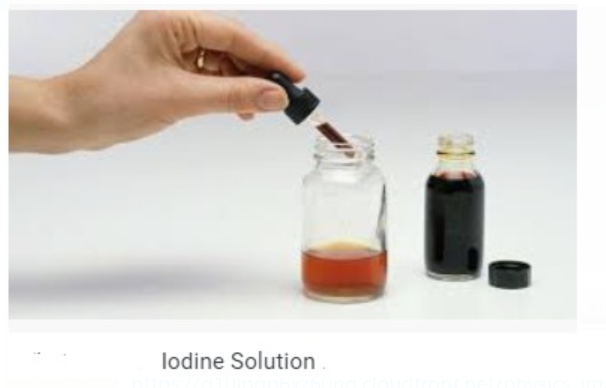
(b) Air - Air homogeneous mixture of different gases hoti h. Isme se oxygen (21 %) aur nitrogen (78 %) main constituents hote h aur baki gases small proportion meh present hoti h. Ye solution gas in gas ka (gaseous solution) example h.
(c) Potassium permanganate crystals in water - In this purple solution, potassium permanganate solute hota h aur water solvent hota h. Ye solution solid in liquid (liquid solution) ka example h .
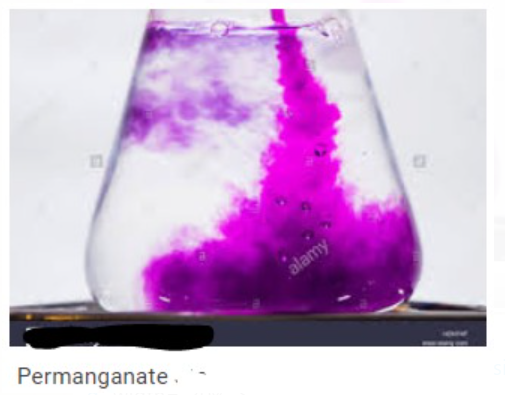
(d) Dilute hydrochloric acid - Iss case meh solute aur solvent dono hi liquids hote h, jis wajah se ye liquid solution ka example hota h.
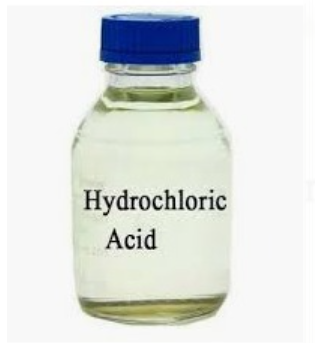
Properties of Solutions
(i) Ek solution homogeneous mixture hota h.
(ii) In a solution, solute particles ka size normally less than 10−9 metre (1 nm) in diameter hota h. As a result, inn particles ko hum naked eye se nahi dekh sakte h aur isse hum microscope se b nahi dekh sakte h.
(iii) Ab kyunki inn particles ka size small hota h, jis wajah ye particles beam of light ko scatter nahi karte h jo solution se paas hoti h. So, path of light solution meh visible nahi hota h i.e., ye tyndall effect show nahi karte h.
(iv) In a solution, solute particles itne chote hote h ki ye filter papers ke fine pores se easily paas kar sakte h. Iska matlab solute ko hum solvent se filtration process se separate nahi kar sakte h.
(v) Jab hum solute particles ko disturb nahi karte h, tab bhi ye particles settle down ho kar separate nahi hote h that is solution is very stable.
Solutions
In the discussion of homogeneous mixtures we have mentioned that a solution is a homogeneous mixture of two or more substances. A homogeneous mixture means that the mixture just remains the same throughout.
Although a solution can have any number of components but a solution mainly consists of 2 components - Solute and Solvent such solutions are called binary solutions.
Solute is the component present in less quantity whereas solvent present in larger quantity. Some common examples of solutions are : Salt solution, Sugar solution, Vinegar, Metal alloys (such as Brass) and Air.
Salt solution is a homogeneous mixture of two substances, salt and water, whereas sugar solution is a homogeneous mixture of two substances, sugar and water. Salt solution and sugar solution are also known as true solutions because in these solutions, the particles of salt and sugar are mixed so well with water that we cannot distinguish one from the other.
For example - While making lemonade we mix sugar and lemon juice both, in this sugar and lemon juice are solute whereas water which is in large quantity is solvent, and after mixing we cannot tell which part of lemonade has lemon juice in it and which has sugar hence it is a true solution.

Types of Solutions
In a binary solution any of the solute and solvent can be solid, liquid or gas. But on the basis of nature of solvent we have categorised it into three types:
(i) Solid Solutions : In these solutions, solid acts as the solvent.

(ii) Liquid Solutions : In these solutions, liquid acts as the solvent.
(iii) Gaseous Solutions : In these solutions, gas acts as the solvent.

Note: (1) Only a mixture of miscible liquids is a solution. In case they do not mix with each other and form separate layers (e.g., oil and water) it is known as emulsion.
(2) Few examples of the solutions:
(a) Iodine in alcohol - Here, iodine (a crystalline violet solid) is the solute and alcohol (ethyl alcohol) behaves as the solvent.The solution is quite often known as tincture of iodine.
It is used as an antiseptic for wounds treatment. It is an example of solid in liquid solution (liquid solution).

(b) Air - It is a homogeneous mixture of different gases. Out of these, oxygen (21%) and nitrogen (78%) are the main constituents while the other gases are present in small proportions. It is a solution of gas in gas (gaseous solution).
(c) Potassium permanganate crystals in water - In this purple solution, potassium permanganate acts as the solute while water is the solvent. It is an example of solid in liquid solution (liquid solution).

(d) Dilute hydrochloric acid - In this case, both the solute and solvent are liquids. So it is an example of liquid solution.
Properties of Solutions
(i) A solution is a homogeneous mixture.
(ii) In a solution the size of the solute particles is normally less than 10−9 metre (1 nm) in diameter. As a result, these particles cannot be seen with naked eye and even with the help of microscope.
(iii) Because of very small particle size, they do not scatter a beam of light passing through the solution. So, the path of light is not visible in a solution, i.e. do not show tyndall effect .
(iv) In a solution, the solute particles are so small that they can pass through the pores of even fine filter papers. This means that solute cannot be separated from the solvent by filtration.
(v) The solute particles do not settle down when left undisturbed, that is, a solution is very stable.
Hello Points!
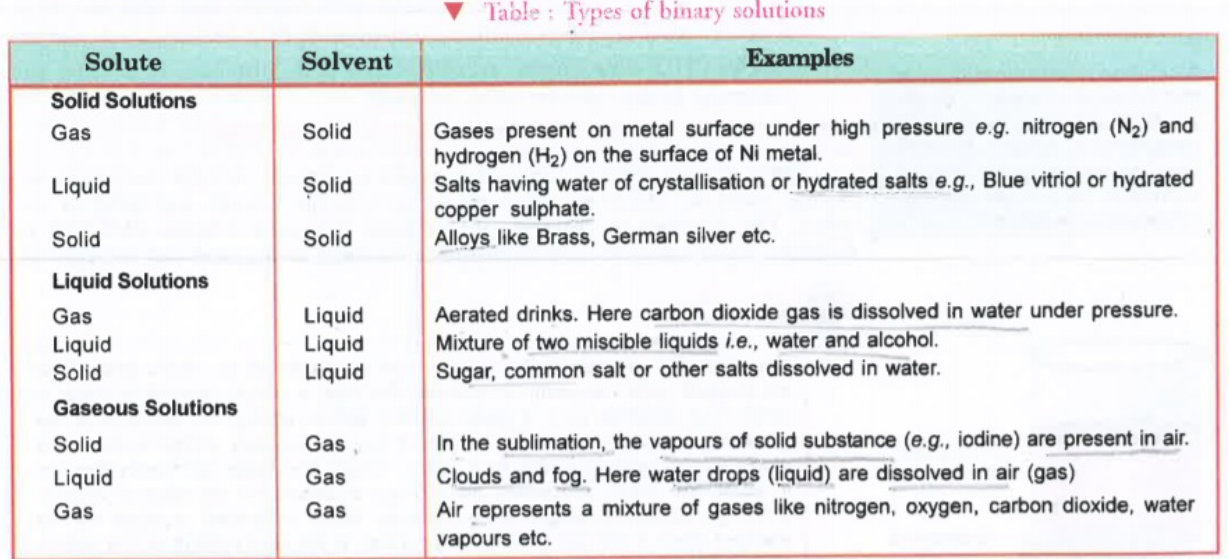
Saturated & Unsaturated Solutions
Although hume 9 different types of solutions known h, lekin inme se most common solution wo h jisme liquid solvent hota h aur solid solute hota h. Isme b same quantity of solvent meh different amount of solute present hota h jiske basis par hum different concentrations ke solution bana sakte h.
For example different amount of salt in water aur sugar in water ke solution iss type ke solution ko belong karte h. Inn solutions ko hum further saturated aur unsaturated solutions meh classify kar sakte h.
Saturated Solutions
Jaise hum sabko chocolate milkshake bahut pasand hota h, iss wajah se hum milk meh large amount of cocoa powder ko add karte h. Lekin later on ek aisa point aata h, jab hum milk ko jitna chahe stir kare tab cocoa powder or sugar dissolved nahi hote h aur tab ye milk ke oopar float karte rahte h. As a result, tab hum iss solution ko saturated solution bolte h.
So, at a given temperature ek solution saturated tab banta h jab solute particles bottom of the container meh settled ho jate h. Ab iss temperature par saturated solution meh jo amount of solute present hota h, usse hum solubility bolte h. Also, agar solution meh amount of solute less than saturation level ho, tab hum uss solution ko unsaturated solution bolte h.
Saturated solution ko jab hum heat karte h tab ye unsaturated ban jata h, as temperature increase karne par solute ki solubilty increase hoti h but not indefinitely. For example agar hum saturated milkshake ko consider kare jisme sugar aur cocoa powder h, so jab hum isko slowly heat karte h tab hum ye find karte h ki sugar aur cocoa powder container ke bottom meh slowly dissolve ho jata h, later on solution clear ho jata h. As a result, heating par solution unsaturated ban jata h.
Also, saturated solution ko jab hum cool karte h tab ye supersaturated ban jata h.
Saturated & Unsaturated Solutions
Although nine different types of solutions are known, the most common among them are those in which liquid acts as the solvent and solid as the solute. In this different amount of solute may present in same amount of solvent, with the help of this we can make solution of different concentrations.
The solutions of different amount of salts in water and sugar in water all belong to this type of solutions. These solutions have been further classified as saturated and unsaturated.
Saturated Solutions
We all love chocolate milkshake and to satisfy our greed we put a large amount of cocoa powder in milk but there comes a point when no matter how much we stir the milk no more cocoa powder or sugar can be dissolved and it will just floating at the top of the milk. That is because the solution has now become saturated.
A solution becomes saturated if the solute starts settling down at the bottom of the container in which the solution is being prepared at a given temperature. The amount of the solute present in the saturated solution at this temperature is called its solubility. If the amount of solute contained in a solution is less than the saturation level, it is called an unsaturated solution.
Saturated solutions generally become unsaturated upon heating, as on heating the solubility of solute increases but not indefinitely. If the saturated milkshake containing sugar and cocoa solution is heated slowly, we find that sugar and cocoa deposited at the bottom and it will slowly dissolve till the solution becomes clear. This shows that the solution has become unsaturated upon heating.
A saturated solution becomes supersaturated upon cooling.
Suspensions
Homogeneous mixtures ko hum solutions or true solutions bolte h. Iske alawa heterogeneous mixtures meh different components more than one phase meh hote h or two different types ke components hote h. Inko hum suspensions aur colloidal solutions bolte h.
Thus, hum yahan ye conclude kar sakte h ki overall three different types ke mixture solutions hote h i.e., solutions (or true solutions), colloidal solutions aur suspensions. Inn mixture solutions ka particles size different hota h, jis wajah se inki properties b different hoti h. Ab true solutions meh size of the particles less than 1 nm hota h (1 nm = 10−9 m = 10−7 cm). Colloidal solution meh size of the particles in between 1 to 100 nm hota h aur suspension meh size of the particles more than 100 nm hota h.
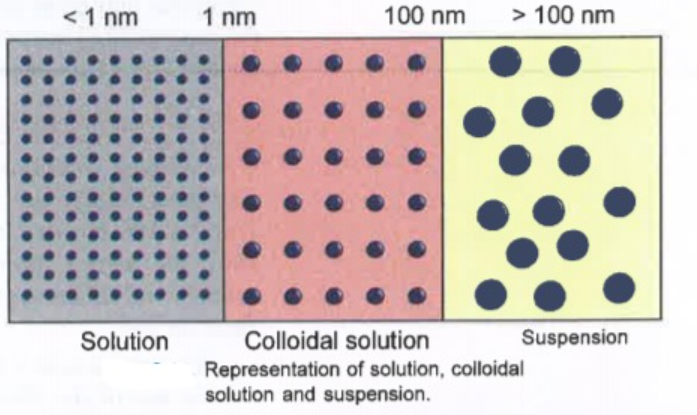
Suspension
Non-homogeneous systems jisme solids, liquids meh dispersed hote h usse hum suspension bolte h. So, suspension ek heterogeneous mixture hota h jisme solute particles dissolve nahi hote h, lekin ye throughout the bulk of the medium suspended rahte h. Suspension ke particles naked eye se visible hote h.
For example Chalk-water, sand particles suspended in water, flour in water, milk of magnesia.
Isme chalk water ka mixture - suspension of fine chalk particles in water hota h, milk of magnesia - suspension of magnesium hydroxide in water hota h.
Solid particles aur water suspension meh separate rahte h, yahan particles water meh dissolve nahi hote h.

Ab nature of suspensions ko study karne ke liye hum ek experiment perform karte h:
(a) Jab hum bubbles of carbon dioxide ko glass tube meh liye lime water se pass karte h, tab lime water milky white ho jata h.
(b) Ab lime water dilute aqueous solution of calcium hydroxide hota h jo carbon dioxide ke sath combine karne par calcium carbonate aur water banata h.
(c) Yahan solid particles of calcium carbonate ka size more than 100 nm hota h aur solution milky hota h. Therefore, iss milky solution ko hum Suspension bolte h.
(d) Ab iss solution ko hum ek glass beaker meh transfer karte h jahan isse settle hone ke liye hum beaker ko kuch time ke liye undisturbed rakhte h. As a result, solid particles slowly bottom of the beaker settled ho jate h aur tab koi b particle motion meh nahi hota h. Jisse hum yahan precipitation bolte h aur iss case meh precipitate ka colour white hota h.
Properties of Suspension
(i) Ek suspension heterogeneous nature ka hota h jiske 2 phases hote h. Isme solid particles ek phase ko represent karta h, while liquid dusre phase ko represent karta h jisme solid particles suspended or distributed hote h.
(ii) Suspension meh particles size more than 100 nm hota h (or 10−7 m).
(iii) Suspension ke particles naked eye aur microscope se dekhe ja sakte h.
(iv) Suspension ke solid particles filter paper se pass nahi hote h. So suspension ke solid particles ko hum filtration (using ordinary filter paper) se separate kar sakte h.
(v) Suspension ke particles unstable hote h. Iske particles ko jab hum undisturbed rakhte h tab under the influence of gravity ye particles settled down ho jate h. Iss process ko hum precipitation bolte h.
(vi) Suspension se jab beam of light pass hoti h, tab ye light ko scatter karta h kyunki iske particles ka size quite large hota h. Hence ye yahan tyndall effect show karta h.
Suspensions
Homogeneous mixtures are regarded as solutions or true solutions. The heterogeneous mixtures in which the components are present in more than one phase or the components are of two different types. These are known as suspensions and colloidal solutions.
Thus, we conclude that there are three types of mixture solutions i.e., solutions (or true solutions), colloidal solutions and suspensions. They differ mainly in the size of the particles which are also responsible for the difference in their properties. In a true solution, the size of the particles is less than 1 nm (1 nm = 10−9 m = 10−7 cm). In a colloidal solution, it is between 1 to 100 nm while in a suspension, the size of the particles is more than 100 nm.

Suspension
Non-homogeneous systems, in which solids are dispersed in liquids, are called suspensions. A suspension is a heterogeneous mixture in which the solute particles do not dissolve but remain suspended throughout the bulk of the medium. Particles of a suspension are visible to the naked eye.
For example Chalk-water, sand particles suspended in water, flour in water, milk of magnesia.
Chalk-water mixture is a suspension of fine chalk particles in water, and milk of Magnesia is a suspension of magnesium hydroxide in water.
Solid particles and water remain separate in a suspension, the particles do not dissolve in water.

In order to study the nature of suspensions, let us illustrate a simple experiment.
(a) When bubbles of carbon dioxide gas are passed through lime water taken in a glass tube, the latter becomes milky white (It is a milk like turbid mixture).
(b) The lime water is dilute aqueous solution of calcium hydroxide which combines with carbon dioxide to form calcium carbonate and water.
(c) The solution is milky and the solid particles of calcium carbonate have size more than 100 nm. The milky solution is therefore known as Suspension.
(d) The solution is transferred in a glass beaker and is allowed to settle, the beaker is kept undisturbed for some time. The solid particles slowly settle at the bottom of the beaker and are no longer in motion. This is known as precipitation and in this case, it is white in colour.
Properties of Suspension
(1) A suspension is of heterogeneous nature and has two phases. The solid particles represent one phase while the liquid in which these are suspended or distributed forms the other phase.
(2) The particle size in a suspension is more than 100 nm (or 10−7 m).
(3) The particles in a suspension can be seen with naked eyes and also under a microscope.
(4) The solid particles of suspension do not pass through a filter paper. So, a suspension can be separated by filtration (using ordinary filter paper).
(5) The particles in a suspension are unstable; they settle down after sometime under the influence of gravity when the suspension is kept undisturbed. This process is known as precipitation.
(6) A suspension scatters a beam of light passing through it as its particles size are quite large. Hence, it shows tyndall effect.
Colloids
Colloidal solutions b suspensions ki tarah heterogeneous in nature hote h, lekin inka particles size smaller hota h jo all over the substance distributed hote h.
Inki size range 1 nm to 100 nm hoti h i.e., in between the particle size of true solution aur suspension.
Ye particles beam of visible light ko easily scatter karte h. Iss beam of scattering light ko hum Tyndall effect bolte h, named after the scientist who discovered this effect.
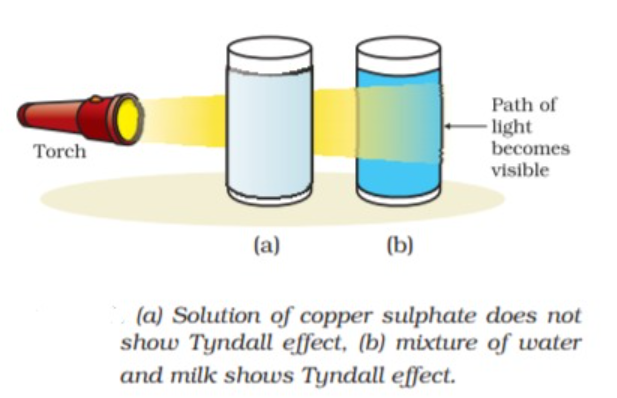
Hum apni daily life meh large variety of the colloidal solutions ko dekhte h. For example chimneys of factories se jo smoke bahar aati h, tooth paste, ink, blood, soap solutions, jellies, starch solution in water.
Note: Tyndall effect ko hum tab bhi observe kar sakte h jab fine beam of light small hole ke through ek room meh enter karti h. Ye scattering of light, particles of dust aur smoke in the air ki wajah se hoti h.
Tyndall effect ko hum apni daily life meh observe sakte h, jaise ek room jisme small window ki opening h. So jab iss opening se sunlight aati h, tab hum path of light aur dust particles dono ko dekh sakte h.
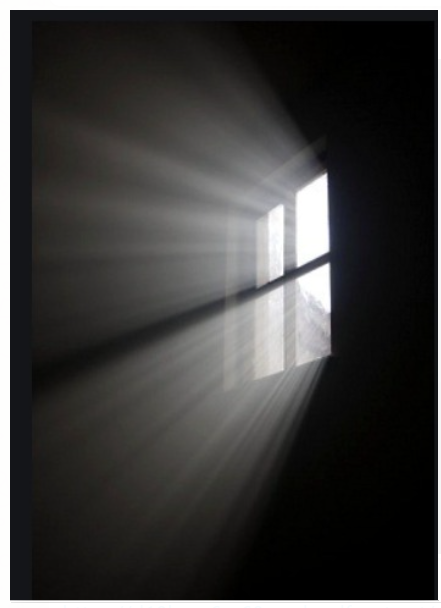
Properties of a Colloid
(1) Colloidal Solutions dikhne meh homogeneous hote h, lekin ye actually heterogeneous nature ke hote h kyunki inka particles size 1 nm to 100 nm hota h jo true solution particles size se bigger hota h.
(2) Colloidal solutions two phase system hote h - dispersed phase and dispersion medium. Iss wajah se colloidal solutions heterogeneous nature ke hote h.
(3) Most of the cases meh colloidal solutions ordinary filter paper se pass kar sakte h jaise true solutions karte h. Kyunki dispersed phase or colloidal particles ka size kafi fine hota h. However ye particles animal membrane jaise parchment membrane or goat skin jinka semipermeable nature hota h, unse pass nahi hote h. Ye sirf dispersion medium ke particles ko pass karte h aur colloidal particles or dispersed phase ke particles ko pass nahi karte h.
(4) Colloidal solution meh particles zig-zag path follow karte h. Normally hum colloidal particles ko inke very small size ki wajah se nahi dekh sakte h. However, inke path ko hum under ultra microscope dekh sakte h, jahan ye zig-zag path follow karte h. Iss motion ko hum theatre meh film ke time par dekh sakte h. Isme jo beam of light piche se screen par fall karti h usme dust particles present hote h aur ye zig-zag path follow karte h.
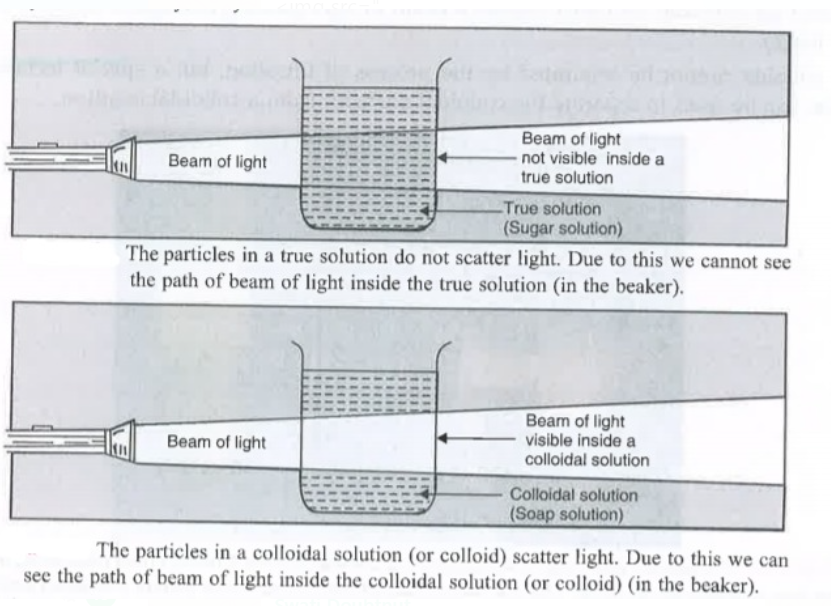
(5) Colloidal solution beam of light ko scatter kar sakta h.
(6) Colloids or colloidal solution stable hote h, jiska matlab isko agar hum undisturbed rakhte h tab iske particles separate nahi hote h.
Applications of Colloidal Solutions
(1) Colloids ko water purification meh use kar sakte h.
(2) Colloidal form meh jo medicines hum lete h, usse body easily absorbed kar sakti h.
(3) Colloidal formation ki wajah se soap, dirty clothes ko clean kar sakte h.
(4) Colloids ko hum food aur food industries meh b at large scale use karte h. Since most of the food jo hum consume karte h wo colloidal in nature hote h. For example milk, cheese etc.,.
Colloids
Colloidal solutions are also heterogeneous in nature like suspensions, but they have a smaller size of the particles which are distributed all over the substance.
It's size ranges between 1 nm to 100 nm i.e. in between the particle size of true solution and suspension.
These particles can easily scatter a beam of visible light. This scattering of a beam of light is called the Tyndall effect, named after the scientist who discovered this effect.

We come across a large variety of the colloidal solutions in daily life. Smoke coming out of the chimneys of factories, tooth paste, ink, blood, soap solutions, jellies, starch solution in water are a few common examples.
Note: Tyndall effect can also be observed when a fine beam of light enters a room through a small hole. This happens due to the scattering of light by the particles of dust and smoke in the air.
We have observed tyndall effect in our daily lives too, like in a room there is an opening of a small window. So, when sunlight comes from this opening we can see the path of light and the dust particles too.

Properties of a Colloid
(1) Colloidal solutions appear to be homogeneous but are actually heterogeneous in nature because of their particle size (1 nm to 100 nm) which is bigger than true solution particles size.
(2) Colloidal solutions are a two phase system. These are dispersed phase and dispersion medium. This is the reason why the colloidal solutions are heterogeneous in nature.
(3) In most of the cases, the colloidal solutions pass through ordinary filter papers like true solutions. This is because of the fine size of the dispersed phase or colloidal particles. However they cannot pass through an animal membrane such as parchment membrane or goat skin which is of semipermeable nature. It allows only the particles of the dispersion medium to pass but not the colloidal particles or the dispersed phase.
(4) Particles in a colloidal solution follow a zig-zag path. It is normally not possible to see the colloidal particles because of their very small size. However, their path can be seen under a ultra microscope. These particles follow a zig-zag path. You can observe this motion while watching a film in a theatre. The beam of light which falls on the screen from behind has dust particles present in it, they follow the zig-zag path.

(5) Colloidal solution scatters the beam of light passing through it.
(6) Colloids or colloidal solution are quite stable. The particles of a colloid do not separate out on keeping.
Applications of Colloidal Solutions
(1) Colloids are used in water purification.
(2) Medicines in colloidal form can be easily absorbed by the body.
(3) Soaps clean dirty clothes due to the formation of colloidal solutions.
(4) Colloids are used in food and food industries at large scale. As most of the food which we consume are colloidal in nature. For example milk, cheese etc.,
Hello Points!
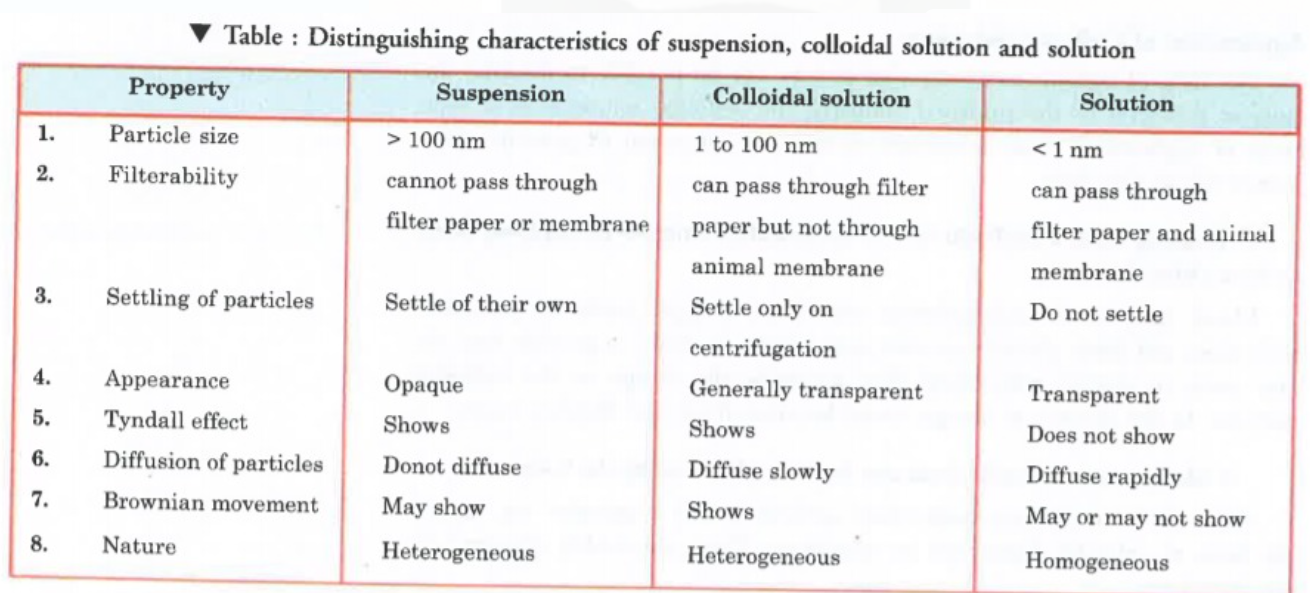
Important Definitions
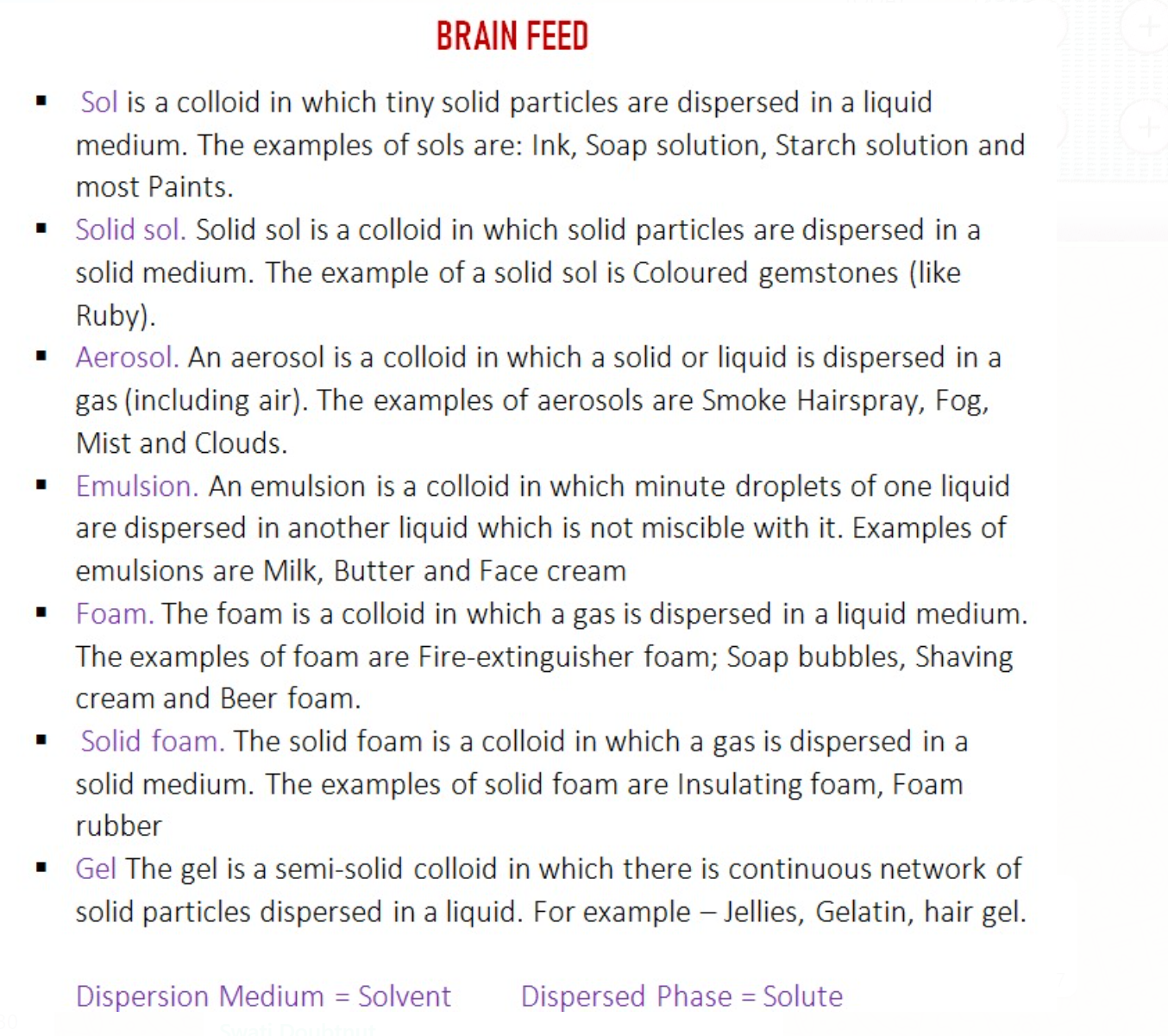
EXAMPLE 5
(a) Identify the solute and solvent in tincture of iodine.
(b) Why is Tyndall effect not seen in a true solution
(a) In tincture of iodine; solute present is iodine and solvent is ethyl alcohol.
(b) In a true solution, the particle size is so small (less than 1 nm) that it does not scatter the beam of light. Therefore, the Tyndall effect is not seen in a true solution.
EXAMPLE 6
What would you observe when:
(a) A saturated solution of potassium nitrate prepared at 60∘C is allowed to cool room temperature?
(b) A mixture of iron filings and sulphur is heated strongly?
(c) A colloidal solution of starch is passed through an ordinary filter paper?
(a) Crystals of potassium nitrate which are needle shaped would slowly appear at the bottom of the container which may be in a china dish or a beaker.
(b) A greyish-black mass of iron sulphide (FeS) is formed.
(c) The solution passes through the ordinary filter paper without leaving any residue.
EXAMPLE 7
On dissolving chalk powder in water, a suspension is obtained. Give any four reasons to support the fact that mixture so obtained is a suspension only.
It is supported by the following reasons :
(i) White particles of chalk powder can be seen with naked eye.
(ii) The particles can be separated by ordinary filter paper.
(iii) Upon shaking, a white turbidity reappears in solution.
(iv) Light cannot pass through the suspension which shows that it is of opaque nature.
EXAMPLE 8
Compare a true solution, a suspension and a colloidal solution with respect to their stability.
In a true solution, the solute particles do not settle down when left undisturbed, that is why a solution is very stable.
The particles in a suspension are unstable; they settle down after sometime under the influence of gravity when the suspension is kept undisturbed. This process is known as precipitation.
Colloids or colloidal solution are quite stable. The particles of a colloid do not separate out on keeping.
EXAMPLE 9
The sea water can be classified as a homogeneous as well as a heterogeneous mixture ? Comment.
When sea water is a mixture of dissolved salts and water only, it is homogeneous; if sea water also contains suspended impurities like decayed plant or water then it is heterogeneous.
Concentration
Concentration of a solution, solute ka wo amount hota h jo given amount of solution (mass or volume) meh present hota h, or jo amount of solute given mass or volume of the solvent meh dissolved hota h usse hum concentration bolte h.
Ek binary solution meh solute aur solvent 2 components or constituents present hote h. Ab solute aur solvent ka solution meh relative amount either by mass or by volume, concentration of solution ko represent karta h.
Expressing the Concentration of a Solution
(i) Mass by Mass Percent : Ek component (solute or solvent) ke number of parts by mass per 100 parts by mass of the solution ko hum mass percent meh express karte h.
Ab agar kisi binary solution meh A aur B two components h tab
Mass Percent of B = Mass of BMass of solution (A+B)×100
(ii) Mass by Volume Percent =
(iii) Volume by Volume Percent : Ek component (solute or solvent) ke number of parts by volume per 100 parts by volume of the solution ko hum volume percent meh express karte h.
Ab agar kisi binary solution meh A aur B two components h tab
Volume Percent of B = Volume of BVolume of solution (A+B)×100
(iv) Strength : Amount of solute in grams present in one litre of the solution ko hum strength bolte h.
For example Find the strength of a solution containing 6 grams of urea in 600 mL of solution.
Solution:
Mass of solute = 6 g
Volume of solution = 600 mL = 6001000 = 0.6 L
Strength = 60.6 = 10 g/L
Concentration
The concentration of a solution is the amount of solute present in a given amount (mass or volume) of solution, or the amount of solute dissolved in a given mass or volume of solvent.
A binary solution has two components or constituents. These are solute and solvent. The relative amounts of the solute and solvent in the solution either by mass or by volume, represent the concentration of solution.
Expressing the Concentration of a Solution
(i) Mass by Mass Percent : It is defined as the number of parts by mass of one component (solute or solvent) per 100 parts by mass of the solution.
If A and B are the two components of a binary solution
Mass Percent of B = Mass of BMass of solution (A+B)×100
(ii) Mass by Volume Percent =
(iii) Volume by Volume Percent : It is defined as the number of parts by volume of one component (solute or solvent) per 100 parts by volume of the solution.
If A and B are the two components of a binary solution
Volume Percent of B = Volume of BVolume of solution (A+B)×100
(iv) Strength Strength is the amount of solute in grams present in one litre of the solution.
EXAMPLE 10
A solution has been prepared by dissolving 5 g of urea in 95 g of water. What is the mass percent of urea in the solution ?
Mass percent (Mass %) = Mass of soluteMass of solution×100
Mass of urea = 5 g, Mass of water = 95 g
Mass of solution = (5 + 95) = 100 g
Mass percent of urea = 5g100g×100=5%
EXAMPLE 11
Calculate the masses of cane sugar and water required to prepare 250 g of 25% solution of cane sugar.
Mass percent = 25, Mass of solution = 250 g
∴ 25 = Mass of cane sugar (solute)250g×100
∴ Mass of cane sugar = 25×250g100=62.5g
Mass of water = 250 - 62.5 = 187.5 g
EXAMPLE 12
A solution contains 35 g of common salt in 300 g of water. Calculate the concentration of the solution
Mass of common salt = 35 g, Mass of water = 300 g
Mass of solution = (300 + 35) = 335 g
Concentration of solution = 35g335g×100=10.45%
EXAMPLE 13
A solution contains 5 mL of alcohol mixed with 75 mL of water. Calculate the concentration of the solution in terms of volume percent.
Volume of alcohol = 5 mL
Volume of solution = (5 + 75) = 80 mL
Concentration of solution = 5mL80mL×100=6.25%
EXAMPLE 14
Calculate the strength of a solution containing 5 g of glucose in 200 mL of the solution.
Mass of glucose = 5 g
Volume of solution = 200 mL = 2001000=0.2L
Strength of solution = 5g0.2L=25g/L
EXAMPLE 15
What mass of sodium hydroxide must be dissolved in 500 mL of solution so that the strength of the solution may be 10 g/L ?
Strength of solution = 10 g/L = 10gL−1
Volume of solution = 500 mL = 0.5 L
∴ Mass of NaOH (solute) = (10gL−1)×(0.5L)=5g
Solubility
Solute ki solution meh solubility ko hum hamesha saturated solution ki respect meh express karte h. So solubility wo maximum amount of solute hota h jo 100 g of the solvent meh dissolved hota h in order to form saturated solution at a given temperature. Ab solubility ko determine karne ke liye hum ek glass beaker ko completely clean aur dry karte h. Then at a given temperature weighing pan meh hum isse weigh karte h. Ab iss beaker meh hum itna particular solvent add karte h (say water) such that weight of the solvent exactly 100 g ke equal ho. Further, hum uss solute ko select karte h jiski solubility hume find karni h (example sodium chloride). Iss solute ko hum water meh constant stirring ke sath tab tak add karte h jab tak ye bottom meh settle hona start kare.
Iss stage par solution saturated ho jata h, further iss beaker ko hum again weigh karte h aur kitna exact weight of the solute 100 g of the solvent meh dissolved hota h usse find karte h.
Solubility ko hum hamesha mass of solute per 100 gram of solvent meh express karte h.
For example potassium nitrate ka maximum 32 g, 100 g of water meh at 20∘C dissolved hota h, iska matlab solubility of potassium nitrate is 32 grams at 20∘C.
In other words, the number of grams of solute jo 100 grams of water meh dissolved hota h in order to make saturated solution.
Effect of Temperature and Pressure on Solubility:
(i) Solid in liquid ki solubility temperature increase ke sath increase or decrease ke sath decrease hoti h. For example sugar hot water meh jaldi dissolve hoti h as compare to cold water.
(ii) Solid in liquid ki solubility pressure ke independent hoti h.
(iii) Gases in liquid ki solubility temperature increase ke sath decrease or decrease ke sath increase hoti h. Kyunki jab temperature increase hota h tab kinetic energy increase hoti h jis wajah se gas molecules ki randomness increase hoti h. As a result, ye molecules solution se escape ho jate h aur inki solubility decrease hoti h. Ab issi wajah se jab hum warm water ko aquatic water ke sath mix karte h tab water body ka temperature increase hota h jo further water body meh oxygen gas ki solubility ko decrease karta h. Due to this, aquatic plants and animals died.
(iv) Gas in liquid ki solubility pressure increase ke sath increase aur decrease ke sath decrease hoti h.
Solubility
The solubility of a solute in a solution is always expressed with respect to the saturated solution. It may be defined as the maximum amount of the solute which can be dissolved in 100 g of the solvent to form a saturated solution at a given temperature. In order to determine the solubility, clean a glass beaker and completely dry it. Then weigh it on a weighing pan at a given temperature. Now add a particular solvent (say water) until the weight of the solvent is exactly 100g. Select the solute whose solubility is to be determined (e.g Sodium Chloride). Go on adding the solute in water with constant stirring done with a glass rod till it starts settling down at the bottom.
The solution at this stage is saturated, weigh the beaker again and find the exact weight of the solute that has dissolved in 100g of solvent.
Solubility is always stated as mass of solute per 100 gram of solvent.
For example A maximum of 32 gram of potassium nitrate can be dissolved in 100g of water at 20∘C so that means that the solubility of potassium nitrate is 32 grams at 20∘C.
It can also be explained as that number of grams of solute which can be dissolved in 100 grams of water to make a saturated solution.
Effect of Temperature and Pressure on Solubility:
(i) Solubility of solid in liquid increases on increasing the temperature and decreases on decreasing the temperature. We have observed that when we heat the water, sugar dissolves faster as compared to cold water.
(ii) The solubility of solid in liquid remain unaffected by changes in pressure.
(iii) The solubility of gases in liquids decreases on increasing the temperature and increases on decreasing the temperature. This is because on increasing the temperature the kinetic energy increases which leads to increase in randomness of molecules of gas and they escape from the solution hence solubility decreases. This is the same reason that when warm water is flown in aquatic water the temperature of the water body increases due to which the solubility of oxygen gas in the water body decreases and the aquatic plants and animals die.
(iv) The solubility of gas in liquid increases with increase in pressure and decreases with decrease in pressure.
EXAMPLE 16
4 g of a solute are dissolved in 40 g of water to form a saturated solution at 25∘C. Calculate the solubility of the solute.
Mass of solute = 4 g
Mass of solvent = 40 g
Solubility (in saturated solution) = 4g40g×(100g)=10g
EXAMPLE 17
12 grams of potassium sulphate dissolves in 75 grams of water at 60∘C. What is its solubility in water at that temperature ?
Here we have been given that 75 grams of water dissolves 12 grams of potassium sulphate.
We have to find how much potassium sulphate will dissolve in 100 grams of water.
Now, 75 g of water dissolves = 12 g of potassium sulphate
So, 100 g of water will dissolve = 1275×100 g of potassium sulphate = 16 g
Thus, the solubility of potassium sulphate in water is 16 g at 60∘C.
Physical & Chemical Changes
Ab kuch reactions aisi hoti h jisme koi new compound nahi banta whereas kuch reactions meh totally different compound banta h, so such changes in the form of reaction ko hum Physical aur Chemical changes respectively bolte h.
Physical Change
Ab jaise ki iske naam meh physical change h, jiska matlab under suitable conditions iss case meh physical state of matter ka change hota h. Ab jaise ki hume pata h ki matter or iski different forms meh interparticles space hota h. So during physical changes matter ke interparticle spaces or forces meh change hota h.
For example jab hum ice ko heat karte h tab inke particles ke beech intermolecular spaces or forces change hoti h jis wajah se ice state of matter pehle water (melting) meh then water vapours (boiling) meh change hoti h. Also, jab hum isse cool karenge tab ye process reversed ho jata h i.e., pehle water vapour changes to water then it changes to ice (pehle condensation, then freezing).
Moreover, physical changes meh substances ki chemical identities change nahi hoti h.
For example water teeno states of matter meh blue litmus or red litmus ka colour change nahi karta h. Iska matlab water remains neutral towards litmus.
Important Characteristics Associated with Physical Changes
(1) Physical change meh substance ki physical state meh change aata h due to change in interparticle spaces or interparticle forces.
(2) Ab during physical change, substance ki composition meh koi change nahi aata h.
(3) Jo substance physical change show karta h, uss wajah se uski characteristics meh koi change nahi aata h.
(4) Physical change meh koi new substance form nahi hota h.
(5) Physical change temporary hota h aur jin conditions par ye change hota h usko jab hum reverse karte h tab ye process b reversed ho jata h.
Chemical Change
Ab jaise ki iske naam meh chemical change h, jiska matlab iss case meh chemical composition of matter change hoti h. Actually, chemical change meh jo substances participate karte h wo ek dusre ke sath combine karte h.
Ab during chemical change, constituents ka exchange hota h aur new substances ka formation hota h. Iska matlab chemical changes, chemical reactions ki wajah se hote h.
For example
Characteristics Associated with Chemical Changes
(1) Chemical change ki wajah se physical state of the substance change ho b sakti h aur nahi bhi.
(2) Chemical changes meh chemical composition of the substances hamesha change hoti h.
(3) Also, chemical change meh characteristics of the substance b hamesha change hoti h.
(4) Chemical changes meh hamesha new substances form hote h.
(5) Chemical changes permanent hote h aur ye most of the cases meh irreversible hote h.
Physical & Chemical Changes
There are some reactions in which no new compounds are formed whereas some in which a totally different compound is formed such changes in the form of reaction are known as Physical and Chemical changes respectively.
Physical Change
A physical change as the name suggests, brings about a change in the physical state of matter under suitable conditions, as we know that there are inter-particle spaces present in matter and its forms. The physical changes occur when there is some change either in these inter-particle spaces or forces.
For example The change of state of ice to water (melting) and then to water vapours (boiling) is because of these changes in intermolecular spaces or forces which occur upon heating. These get reversed when they are cooled i.e. first water vapour changes to water then it changes to ice (first condensation, then freezing).
During the physical changes, the chemical identities of the substances do not change.
For example in all the three states, water does not change the colour of either blue litmus or red litmus. This means that it remains neutral towards litmus.
Important Characteristics Associated with Physical Changes
(1) A physical change involves a change in the physical state of a substance by changing either the interparticle spaces or interparticle forces.
(2) There is no change in the composition of the substances during the physical change.
(3) The substances undergoing physical change don't change their main characteristics.
(4) No new substance is formed during a physical change.
(5) The change is temporary and can be reversed by reversing the conditions which bring about the change.
Chemical Change
A chemical change as the name suggests, brings a change in the chemical composition of the matter. Actually, the substances which are participating in a chemical change have to combine with each other.
During this, there is an exchange of their constituents and new substances are formed. This means that chemical changes occur on account of the chemical reactions.
For example
Characteristics Associated with Chemical Changes
(1) As a result of chemical change, the physical state of the substance may or may not change.
(2) There is always a change in the chemical composition of the substances undergoing chemical changes.
(3) There is also change in characteristics of the substances involved in these changes.
(4) New substances are always formed during chemical changes.
(5) The chemical changes are permanent changes which are mostly irreversible.
Hello Points!
The main point of differences between Physical and Chemical Changes

Separation
Jaise ki humne abhi tak padha ki mixtures whether homogeneous or heterogeneous, pure substances ke mixing se bante h i.e, from elements aur compounds.
Mixtures ke formation meh koi chemical reaction nahi hoti h. Sometimes hume given mixture ke substances ko separate karna hota h. Moreover, many cases meh substances naturally impure hote h.
Ab different compound ke purification ke liye certain techniques hoti h aur mixture ke constituents ka separation following factors par depend karta h:
(i) Type of Mixture (homogeneous or heterogeneous)
(ii) Nature of the substance present in the mixture
Ab separation of mixtures ko padhne ke liye hum following 3 cases consider karte h:
1) Mixture of two solids
2) Mixture of a solid and a liquid
3) Mixture of two liquids
Separation
We have learnt that mixtures whether homogeneous or heterogeneous result from the mixing of pure substances i.e. elements and compounds.
No chemical reactions occur in the formation of mixtures. Sometimes, we are required to separate these substances present in a given mixture. Moreover, in many cases the substances occur naturally as impure.
There are certain techniques used to purify these compounds and the separation of constituents from a mixture depends upon:
(i) Type of Mixture (homogeneous or heterogeneous)
(ii) Nature of the substance present in the mixture
In order to learn the separation of mixtures, we will consider the following three cases :
1) Mixture of two solids
2) Mixture of a solid and a liquid
3) Mixture of two liquids
1) Mixture of Two Solids
Sabhi mixtures jisme 2 solid substances hote h, unhe hum one of the following methods se separate kar sakte h:
(i) By using a suitable solvent
(ii) By the process of sublimation
(iii) By using a magnet
(i) Separation by a Suitable Solvent
Kuch cases meh mixture ka ek constituent particular liquid solvent meh soluble hota h whereas other constituent insoluble hota h. Ab constituents ki iss solubility difference ki wajah se hum inhe mixture se separate kar sakte h.
For example agar hum sugar aur sand solution consider kare, toh isme sugar, water meh soluble hoti h lekin sand insoluble hoti h. So accordingly hum iss mixture of sugar aur sand ko water as solvent ki help se separate kar sakte h.
To Separate a Mixture of Sugar and Sand by using Water as solvent
(a) Sabse pehle hum sand aur sugar ko ek beaker meh lete h, then isme water add kar kuch time ke liye stir karte h.
(b) Ab hum yahan ye observe karte h ki sugar, water meh completely dissolved hoti h aur sand dissolved nahi hoti h.
(c) Ab hum funnel ko filter paper ke sath adjust karte h aur beaker ke solution ko pour karte h.
(d) Ab humne yahan ye observe kiya ki sugar solution jisme sand h wo yahan funnel par rakhe filter paper se filtered hota h. Yahan filter paper par sand as residue aur funnel ke niche rakhe beaker meh sugar solution as filtrate obtained hota h.

So iss tarah hum mixture of sugar aur sand ko water as solvent ki help se separate kar sakte h. Iske alawa agar hum sugar ki jagah salt consider kare tab bhi hamara result same hi rahega.
(ii) Separation by Sublimation
Jab solid substance ko hum heat karte h aur ye directly vapours meh convert ho, instead of liquid state uss process ko hum sublimation bolte h. In other words, cooling par vapours directly solid state meh convert ho jaye, usse b hum sublimation bolte h.
Sublimation process ko hum mixture ke unn substances ko separate karne ke liye use karte h jo heating par sublime hote h. Also, jab hum vapours ko cool karte h, tab hume jo solid substance milta h usse hum sublimate bolte h. Ab substances jaise ammonium chloride, iodine, camphor, naphthalene, anthracene heating par sublime hote h aur inke vapours ko jab hum cool karte h tab hum inhe sublimate ki form meh recover kar sakte h.

To Separate a Mixture of Common Salt and Ammonium Chloride
Ab ammonium chloride heating par directly solid se gaseous state meh change ho jata h. So, such mixtures jisme sublimable volatile component present hote h unhe non-sublimable impurity (salt in this case) se separate karne ke liye hum sublimation process used karte h.

(a) Iske liye hum ammonium chloride aur salt mixture ko ek china dish meh lete h aur isse perforated filter paper se cover karte h. Ab iske oopar hum inverted funnel rakhte h jisko hum cotton plug se close karte h.
(b) Ab china dish ko hum gently heat karte h, tab volatile substance jo iss case meh ammonium chloride h wo vapour meh convert ho jata h. Then ye vapours perforated filter paper se pass hokar inner surface of the funnel meh deposit ho jate h, jisse hum sublimate bolte h.
(c) Also, yahan non volatile component common salt h wo funnel meh as residue rah jata h. Later hum sublimate ko funnel se scrapped karte h with the help of a spatula.
Iss tatah hum mixture of ammonium chloride aur common salt ko sublimation se separate karte h.
(iii) Separation by a Magnet
Iron is attracted by magnet. Iron ki iss property se hum isse mixture se separate kar sakte h. So kisi mixture meh iron as one of the constituents present ho tab hum magnet ki help se isse separate kar sakte h. For example iron filings aur sulphur mixture ko hum magnet se separate kar sakte h.

Separation of Scrap Iron
Ab factories meh jo waste materials supply kia jata h usme number of scrap metals hote h jaise iron, gold, copper, silver, titanium etc., So, factories meh inn heap of waste materials se scrap iron ko separate karne ke liye hum big electromagnets used karte h jo crane se fitted hoti h. (Jo magnet electric current ki presence meh work karti h usse hum electromagnet bolte h).
For Example Ab hum iss technique se mixture containing ammonium chloride, sand aur iron filings ko kis tarah separate karte h ye discuss karenge.
Iss mixture meh 3 different kinds of components present h - iron filings, sand aur ammonium chloride. Inn teeno ki different properties h jis wajah se inn teeno ka separation b differently hota h.
(a) Sabse pehle hum iss mixture ko paper or petri dish par rakhte h. Then iske aas paas magnet ko move karte h. As a result, iron filings magnet par attached ho jati h. Later hum iron filings ko magnet se remove karte h aur inhe separately collect kar lete h.
(b) Ab remaining mixture meh ammonium chloride aur sand h jisse hum china dish meh transfer karte h. Iske baad hum yahan sublimation process perform karte h jahan ammonium chloride sublimate form karta h aur sand as residue piche rah jati h.
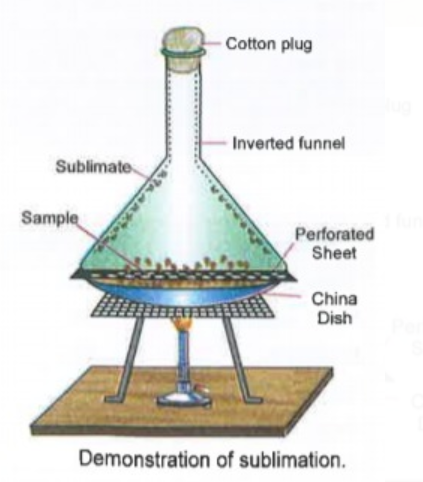
Note: Filter paper ek round piece of special paper hota h jisme millions of tiny pores hote h (tiny holes). Filter paper ke ye pores very small hote h, jis wajah se hum inhe naked eye se nahi dekh sakte h, inhe sirf microscope ki help se dekha jata h. Ab liquids (jaise water, salt solution, oil etc.,) inn filter paper ke tiny pores se pass ho sakte h, lekin solid particles (jaise chalk particles or sand particles) large size hone ke wajah se filter paper ke tiny pores se pass nahi ho sakte h.
Ab filter paper par jo solid rah jata h usse hum residue bolte h.
Similarly, jo liquid filter paper se pass ho jata h usse hum filtrate bolte h.
1) Mixture of Two Solids
All the mixtures containing two solid substances can be separated by one of the following methods :
(i) By using a suitable solvent
(ii) By the process of sublimation
(iii) By using a magnet
(i) Separation by a Suitable Solvent
In some cases, one constituent of a mixture is soluble in a particular liquid solvent whereas the other constituent is insoluble in it. This difference in the solubility of the constituents of a mixture can be used to separate them.
For example let us consider sugar and sand solution, sugar is soluble in water whereas sand is insoluble in it, so a mixture of sugar and sand can be separated by using water as solvent.
To Separate a Mixture of Sugar and Sand by using Water as solvent
(a) Take sand and sugar in a beaker and add water into it, stir the solution for some time.
(b) We observe that sugar has been completely dissolved whereas sand is not dissolved at all.
(c) Then put a filter paper in the funnel and pour the solution of the beaker.
(d) We observe that the sugar solution containing sand is filtered over the filter paper kept in a funnel. Sand remains as a residue on the filter paper and sugar solution is obtained as a filtrate in the beaker placed below the funnel.

In this way, a mixture of sugar and sand has been separated by using water as the solvent. We can also use salt in place of sugar and the result would be same.
(ii) Separation by Sublimation
The changing of a solid substance directly into vapours on heating, and of vapours into solid substance on cooling is called sublimation.
The process of sublimation is used to separate those substances from a mixture which sublime on heating. The solid substance obtained by cooling the vapours is known as sublimate. The substances like ammonium chloride, iodine, camphor, naphthalene and anthracene sublime on heating and can be recovered in the form of a sublimate by cooling their vapours.

To Separate a Mixture of Common Salt and Ammonium Chloride
Ammonium chloride changes directly from solid to gaseous state on heating. So, to separate such mixtures that contain a sublimable volatile component from a non-sublimable impurity (salt in this case), the sublimation process is used.

(a) For this Ammonium Chloride and salt mixture are taken in a China dish and is covered with a perforated filter paper then an inverted funnel is placed on the China dish which is closed with a cotton plug.
(b) The china dish is heated gently then the volatile substance Ammonium Chloride in this case is changes into vapours then these vapours pass through the perforation of the filter paper and get deposited on the inner surface of the funnel this is known as sublimate.
(c) The non volatile component that is common salt remains in the funnel as a residue, then the sublimate is scrapped from the funnel with the help of a spatula.
In this way, a mixture of ammonium chloride and common salt has been separated using sublimation technique.
(iii) Separation by a Magnet
Iron is attracted by a magnet. This property of iron is used to separate it from a mixture. So, if a mixture contains iron as one of the constituents, it can be separated by using a magnet. For example a mixture of iron filings and sulphur can be separated by using a magnet.

Separation of Scrap Iron
Waste materials supplied to factories contain a number of scrap metals including iron like gold, copper, silver, titanium etc. So, in factories, scrap iron is separated from the heap of waste materials by using big electromagnets fitted to a crane (A magnet which works with an electric current is called an electromagnet).
For example Let us see How can we use this technique to separate the constituents from a mixture containing ammonium chloride, sand and iron-filings.
In this case we have three different kinds of components in the mixture, Iron filings, ammonium chloride and Sand, all these three have different properties hence different ways of separation.
(a) Place the mixture on a paper or petridish. Move a magnet over it. Iron filings get attached to the magnet. Scrap off iron filings from the magnet and collect them separately.
(b) The remaining mixture has ammonium chloride and sand transfer it to a china dish and subject it to the sublimation process. Ammonium chloride forms the sublimate while sand is left as residue in the dish.

Note: A filter paper is a round piece of special paper which has millions of tiny pores (or tiny holes) in it. The pores of a filter paper are so small that they cannot be seen with naked eyes.They can be seen only through a microscope. The liquids (like water, salt solution, oil, etc.) can pass through the tiny pores of a filter paper but solid particles (like chalk particles or sand particles) being large, cannot pass through the tiny pores of the filter paper.
The solid which remains behind on the filter paper is called residue.
The liquid which passes through the filter paper is called filtrate.
2) Mixture of a Solid & a Liquid
Jitne b mixtures meh solid aur liquid dono hote h unhe hume one of the following processes se separate kar sakte h.
(i) By filtration
(ii) By centrifugation
(iii) By evaporation
(iv) By crystallisation
(v) By chromatography
(vi) By distillation
(i) Separation by Filtration
Iss method meh hum insoluble solid substances ko liquid se remove karte h by using filter paper. Ye method unn constituents ke liye helpful hota h jisse hum suspension se separate karte h. Ab mixture of chalk aur water ko hum filtration se separate kar sakte h. Jab hum mixture of chalk aur water ko funnel fixed filter paper meh transfer karte h, tab clear water filter paper se pass ho jata h aur isse hum filtrate ki form meh collect kar lete h. Also, chalk pieces filter paper par as residue rah jate h.
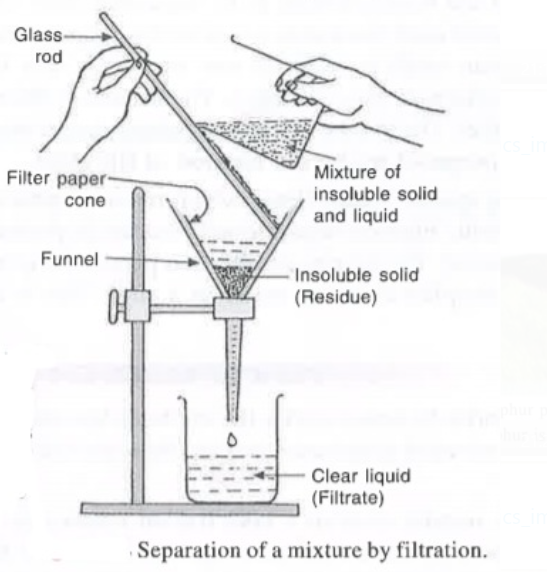
Iske alawa jab hum tea banate h tab some condiments jaise ginger, elaichi etc., add karte h, then hum chalni (sieve) use kar cup meh tea ko dalte h. Iss case meh chalni (sieve) filter paper ki tarah act karti h jo tea ko cup meh as filtrate deti h whereas tea leaves aur other condiments sieve par as residue rah jate h. Drinking water ka purification b hum iss process se karte h.
Water works meh methods jaise sedimentation, decantation, loading, filtration aur chlorination etc., ko hum water se undesirable materials remove karne ke liye use karte h.
Ab river water (or lake water) ke purification ke liye hum following steps use karte h:
(a) Sedimentation Tank: Sabse pehle hum river se with the help of pumping station water ko large reservoir meh pump karte h jisse hum sedimentation tank bolte h.
Iss water ko hum kuch time ke liye sedimentation tank meh undisturbed rakhte h. During this time, many insoluble substances jo water meh present h wo bottom of the tank meh settle ho jate h.
(b) Loading Tank: Ab sedimentation tank se water ko hum loading tank meh transfer karte h. Loading tank meh hum alum (phitkari) ko water meh add karte h. Ab dissolved alum ke heavy particles suspended clay particles in water par deposit ho jate h. Iss tarah suspended clay particles in water, alum particles ke sath load ho jate h aur tab ye heavy hone ki wajah se bottom of the tank par deposit ho jate h. Thus, process of loading (using alums) ki help se hum suspended clay particles ko water se remove kar sakte h.
(c) Filtration Tank: Further water ko hum filtration tank meh transfer karte h. Filtration tank meh 3 layers hoti h : Fine sand layer at the top, coarse sand layer in the middle aur gravel (tiny stones) as the bottom layer. Yahan sand layer aur gravels filters ki tarah kaam karte h. Ab jab water, layers of sand aur gravel se pass karta h, tab even the small suspended particles aur other materials water se remove ho jate h.
(d) Chlorination Tank: Ab clear water ko hum chlorination tank meh transfer karte h, jisme hum little chlorine gas add karte h. Chlorine ko hum yahan germs kill karne ke liye dalte h.
Isko hum disinfecting the water bolte h (or sterilising the water). Ab ye water drinking ke liye safe h, jisse hum apne home meh use kar sakte h for household work.
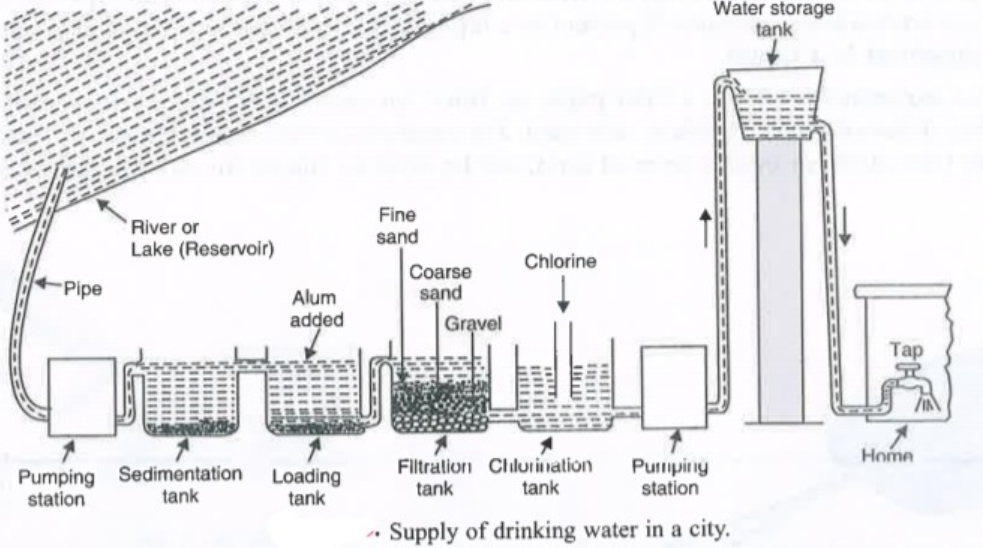
(ii) Separation by Centrifugation
Iss method meh hum substance ke suspended particles ko liquid se centrifuge meh high speed rotation ke sath separate karte h.
Ab certain liquid mixtures meh solid particles very small hote h jis wajah se ye filter paper se easily pass ho jate h. So filtration technique se hum inn particles ko separate nahi kar sakte h jis wajah se inn compounds ke separation ke liye hum centrifugation technique use karte h. Centrifugation technique ko hum commonly milk se butter separate karne ke liye use karte h. Iske liye centrifugation machine meh hum milk ko high speed meh rotate karte h, isme light weight particles aapas meh collide kar cream form karte h jo lighter hone ki wajah se surface par hi rahti h. Lekin milk ke heavier particles hote h jis wajah se ye bottom meh settled ho jate h. As a result, tab yahan separation ho jata h jisme cream ko hum top of the centrifugation machine outlet se collect kar sakte h aur milk ko hum base of a machine outlet se collect kar sakte h.
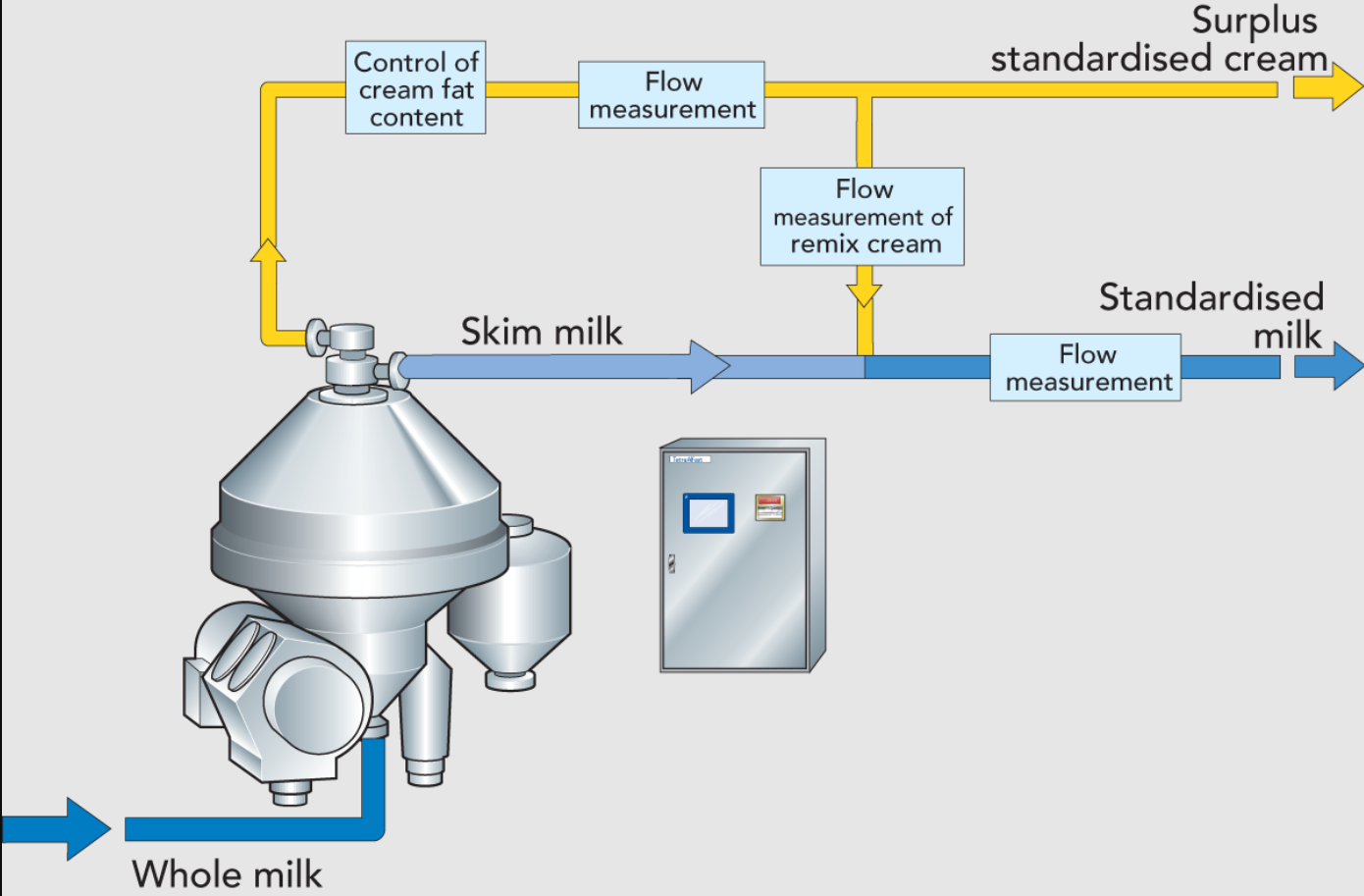

(iii) Separation by Evaporation
Liquid ka vapours meh change hone ko hum evaporation bolte h. Evaporation se hum solid substance ko separate kar sakte h jo water meh dissolved hote h (or any other liquid). Complete water ke evaporation ke baad dissolved substance as solid residue rah jata h. Evaporation ko hum non-volatile solute se volatile component ko separate karne ke liye use karte h.
Evaporation technique ko hum large scale meh use karte h in order to obtain common salt from sea water.

Iske alawa blue ink (or black ink) jo fountain pens meh use hoti h wo liquid mixture hoti h. Ye dye in water ka mixture hoti h, iss dye ki wajah se ink ka colour blue or black hota h. Evaporation process ki help se hum coloured component of ink (dye from ink) ko separate kar sakte h.
Experiment to Obtain Coloured Component (Dye) from Ink
(a) Sabse pehle hum ek beaker ko water se half fill karte h aur isse watch glass se cover karte h. Then watch glass meh hum ink drops daalte h.
(b) Then hum iss beaker ko heat karte h but not at very high flame kyunki agar hum isse high flame par heat karenge tab ink immediately evaporate ho jayegi. Hence, flame ko hum evaporation ke liye low rakhte h.
(c) Ab jab tak yahan evaporation hoga tab tak hume isse heat karenge. Later jab watch glass par koi change na ho tab hum heating ko stop kar denge.
(d) Tab hum yahan ye observe karte h ki watch glass ke surface par small amount of solid coloured material present hota h. Ye coloured material dye h jo ink meh present thi.
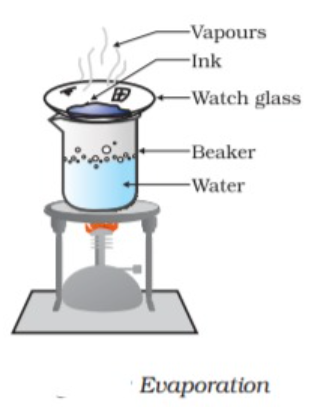
Similarly, mixture of common salt aur water ko b hum evaporation se separate kar sakte h. As after evaporation of water yahan common salt rah jata h. Since common salt, water meh soluble hota h iss wajah se hum isse crystallisation method se b separate kar sakte h. Also, yahan hum process of distillation ko b use kar sakte h, kyunki sodium chloride non-volatile aur water volatile hota h.
(iv) Purification of Crystallisation
Iss process meh hum hot concentrated solution of substance ko cool karte h to obtain crystals.
Kisi substance ki purest form crystals hote h, jinki definite geometrical shapes hoti h. So jis process se hum impure compound ko inke crystals meh convert karte h usse hum crystallisation bolte h.
Process of crystallisation ko hum impure sample se pure solid substance obtained karne ke liye use karte h. Iss process se hum large number of water soluble solids ko purify kar sakte h.
Iss process ko samajhne ke liye hum following experiment consider karte h:
(a) Sabse pehle hum 5 gram impure copper sulphate lete h aur isse china dish meh least amount of water meh dissolved karte h. Then isse hum filter paper se filter karte h (so that insoluble or suspended impurities remove ho jaye). Ab hum iss filtrate ko china dish meh evaporate karte h, so that hume yahan saturated solution mil jaye.
(b) Ab hum iss hot saturated solution ko few hours ke liye undisturbed rakh dete h, jisme se tab crystals of pure copper sulphate separate ho jate h.
(c) Ab hum inn copper sulphate crystals ko ordinary filter paper se filter kar separate kar lete h aur after separation of crystals jo filtrate rah jata h usse hum mother liquor bolte h.
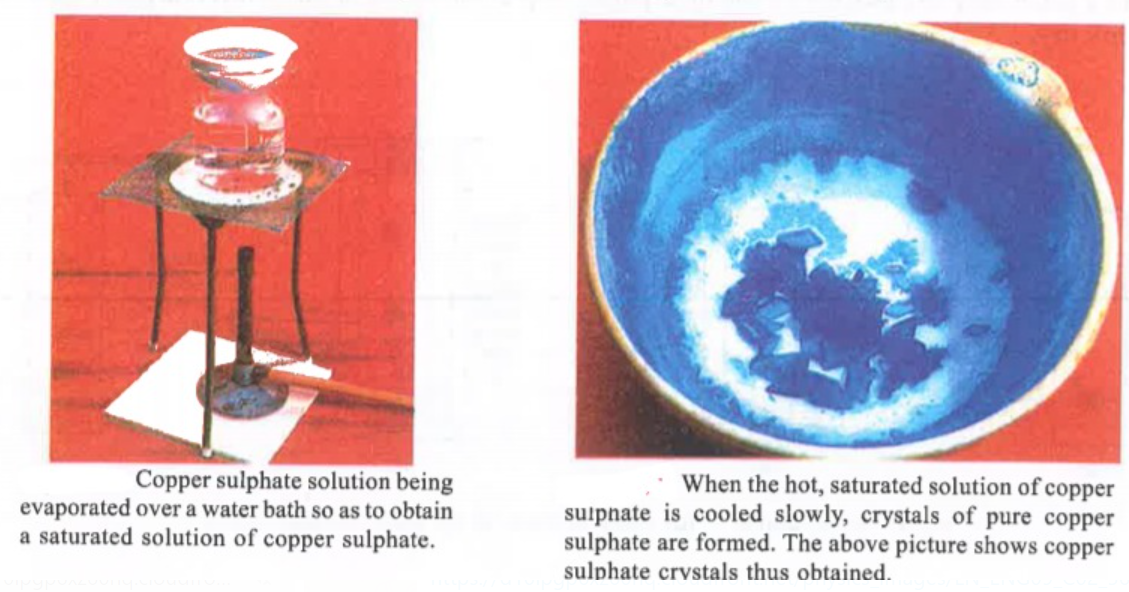
Advantages of Crystallisation over Evaporation
(a) Crystallisation ek better technique h as compared to evaporation kyunki evaporation meh hum solution ko dryness tak heat karte h jis wajah se kuch solid substance decompose ho jate h aur kuch jaise sugar charred ho jate h.
(b) Evaporation technique se hum soluble impurities ko remove nahi kar sakte h, lekin crystallisation se ye possible hota h.
(v) Separation by Chromatography
Chromatography technique ko hum two or more dissolved solids ko separate karne ke liye use karte h jo solution meh small amount meh present hote h.
Generally many types of chromatography hoti h, lekin isme simplest form paper chromatography hoti h. Iske liye hum most commonly Whatman paper use karte h, iske alawa hum ordinary purpose ke liye ordinary filter paper b use kar sakte h. Ab kuch cases meh two or more different substances, same solvent meh soluble hote h lekin inki solubilities different hoti h matlab ek component dusre ki respect meh jyada soluble hota h aur substances ki inn properties ki wajah se hum inhe chromatography process se separate kar sakte h.
Jab hum ek solvent example water ko inn mixture of substances se pass karte h, tab jo component water meh jyada soluble hota h wo along the water move karta h iss wajah se iska spot higher aata h whereas jo component water meh less soluble hota h wo piche rah jata h. Thus, mixture ke various parts ko hum other substances se separate kar sakte h.
To Separate the Dyes Present in the Ink
(a) Sabse pehle hum thin strip of filter paper lete h.
(b) Then iske lower edge se 3 cm above ek line draw karte h with the help of pencil.
(c) Ab hum centre of the line par small drop of ink lagate h (water soluble, i.e., from a sketch pen or fountain pen) aur isse drying ke liye chhod dete h.
(d) Ab hum glass jar/beaker meh some amount of water lete h so that filter paper par jo drop of the ink h wo water level ke above ho. Then hum isse undisturbed chhod dete h.
(e) Now watch carefully, filter paper par water rise karta h. Ab jaise water rise karta h by the capillary action, tab ye over the spot flow karta h along with the dye particles.
Usually ink two or more coloured dyes ka mixture hoti h, isme jo component jyada soluble hota h wo faster rise karta h aur iska paper par spot b higher position par hota h. Iska matlab jitni jyada solubility utna higher coloured spot aur jitni kam solubility utna lower spot.
(f) Jab water top end of the filter paper strip par pahunch jata h tab hum isse glass jar/beaker se remove karte h aur isse dry hone dete h. Ab iss paper par separate coloured spots hote h jisse hum chromatogram bolte h.
Applications of Chromatography
(a) Isko hum coloured substances ke solutions ko separate karne ke liye use karte h (dyes aur pigments)
(b) Isko hum forensic science meh very minor amount of substances jaise toxins, poisons etc., ko identify aur detect karne ke liye use karte h.
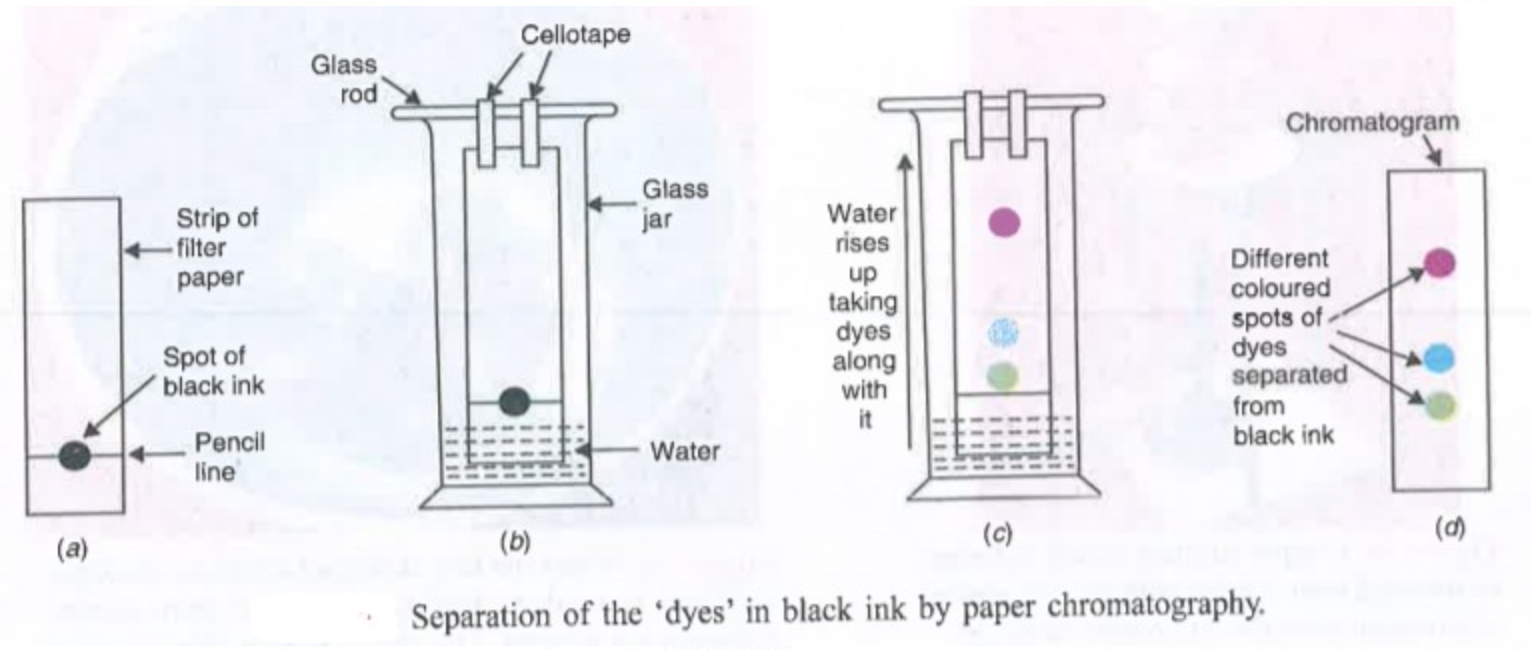
(vi) Separation by Distillation
Distillation process meh jab hum liquid ko heat karte h tab ye vapours meh convert hota h aur jab hum vapours ko condense karte h tab ye liquid meh again convert ho jata h.
Ab iss process meh vapour ko condense karne par hume jo liquid milta h usse hum distillate bolte h.
Distillation process ko hum mixture of 2 miscible liquids separate karne ke liye use karte h, jo without decomposition boil hote h aur inke boiling point meh sufficient difference (30-50 K) hota h.
Ab hum mixture of acetone aur water ko distillation process se kaise separate kar sakte h wo study karenge:
Acetone ka boiling point 329 K aur water ka 373 K hota h.
(a) Jab hum iss mixture ko heat karte h tab yahan sabse pehle low boiling point substance means acetone ke vapours form hona start hote h.
(b) Ab heating ke sath vapours jab upward move karte h tab thermometer ka temperature increase hone lagta h aur jab acetone ka vapour pressure equal to atmospheric pressure hota h, tab acetone boil hone lagta h. Ab jab ye vapours, condenser se pass hote h tab ye condensed hokar liquid form karte h.
(c) Yahan se acetone ko hum beaker meh collect karte h aur jab whole of the acetone distilled ho jata h, tab thermometer ka temperature decrease hone lagta h.
(d) Further, jab hum heating ko kuch time ke liye continue rakhte h tab high boiling point substance ke vapours upward move karte h. As a result, temperature of thermometer increase hone lagta h aur jab vapour pressure of water atmospheric pressure ke equal ho jata h, tab ye boil karna start karta h aur isko b hum acetone ki tarah collect kar lete h.
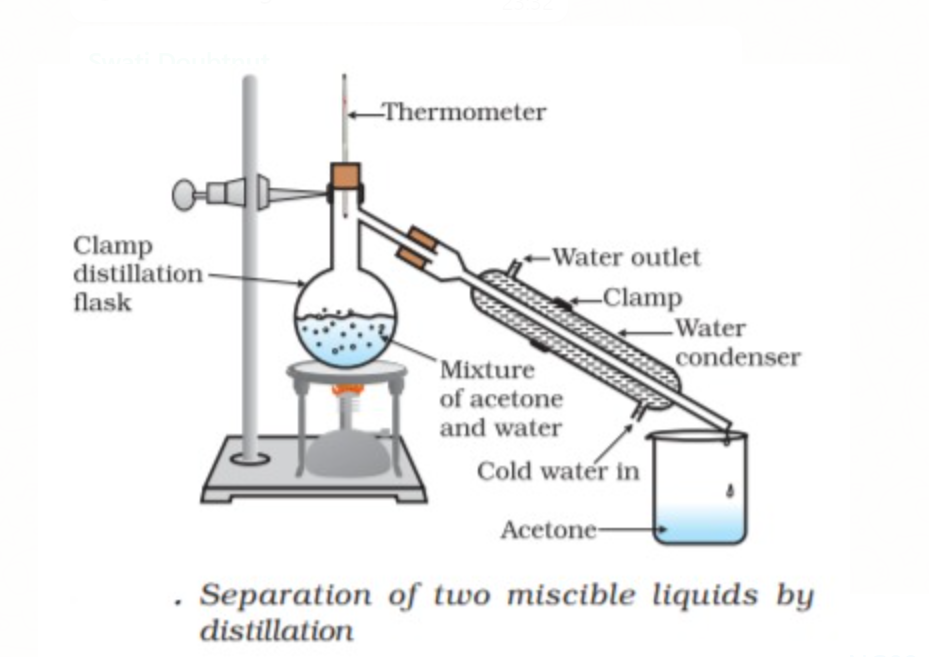
Similar process ko hum mixture of salt aur water ko separate karne ke liye use kar sakte h.
2) Mixture of a Solid & a Liquid
All the mixtures containing a solid and a liquid are separated by one of the following processes :
(i) By filtration
(ii) By centrifugation
(iii) By evaporation
(iv) By crystallisation
(v) By chromatography
(vi) By distillation
(i) Separation by filtration
The process of removing insoluble solid substances from a liquid by using a filter paper is known as filtration. This method is particularly useful when the constituents are to be separated from a suspension. A mixture of chalk and water is separated by filtration. When the mixture of chalk and water is poured on the filter paper fixed in a funnel, then clear water passes through the filter paper and collects as filtrate whereas the chalk pieces are left behind in the filter paper as residue.

While making tea we add some condiments such as ginger, elaichi, e.t.c. and afterwards we use a sieve (Chalni) to pour it in a cup, in this case the sieve is working as a filter paper and the tea in the cup is filtrate whereas the tea leaves and other condiments left in the sieve are residue. Purification of drinking water is also done by this process.
In water works, the methods like sedimentation, decantation, loading, filtration and chlorination, etc., are used to remove undesirable materials from water.
The purification of river water (or lake water) is done in the following steps :
(a) Sedimentation Tank: The water from a river (or lake) is pumped by the pumping station into a large reservoir called sedimentation tank.
This water is allowed to stand in the sedimentation tank for some time. During this time, many of the insoluble substances present in water settle down at the bottom of the tank.
(b) Loading Tank: From the sedimentation tank, water is sent to a loading tank. In the loading tank, some alum (phitkari) is added to water. The heavy particles of dissolved alum deposit on the suspended clay particles in water. In this way, the suspended clay particles in water get loaded with alum particles, become heavy and settle down at the bottom of the tank. Thus, the process of loading (by using alum) removes the suspended clay particles from water.
(c) Filtration Tank: The water is then passed through a filtration tank. The filtration tank has three layers : Fine sand layer at the top, coarse sand layer in the middle and gravel (tiny stones) as the bottom layer. The layers of sand and gravel act as filters. When the water passes through the layers of sand and gravel, even the small suspended particles and other materials in water get removed.
(d) Chlorination Tank: The clear water is then passed into a chlorination tank. A little chlorine gas is added to water in this tank. Chlorine is added to water to kill the germs present in it.
This is called disinfecting the water (or sterilising the water). The water now becomes fit for drinking which is used in home for household work.

(ii) Separation by Centrifugation
It is a method for separating the suspended particles of a substance from a liquid in which the mixture is rotated at a high speed in a centrifuge.
In certain cases, the solid particles in a liquid mixture are so small that they easily pass through a filter paper and the particles cannot be separated by the filtration technique so we need to apply the technique of centrifugation to separate such compounds. Centrifugation isn't something new to us this is an old age practice which has been used to separate butter from milk. Milk is rotated at a high speed in a centrifugation machine, the light weight particles collide with each other to form a cream which is lighter and it stays up on the surface while the heavier particles of milk are forced to come to the bottom and they settle down so as a result of which the separation occurs and the cream is collected from the outlet provided near the top of centrifugation machine while the milk is collected through an outlet which is present at the base of a machine.


(iii) Separation by Evaporation
The changing of a liquid into vapours (or gas) is called evaporation. Evaporation is used to separate a solid substance that has dissolved in water (or any other liquid). The dissolved substance is left as a solid residue when all the water (or liquid) has evaporated. Evaporation can be used to separate the volatile component solvent from its non-volatile solute.
The process of evaporation is used on a large scale to obtain common salt from sea water.

Blue ink (or black ink) used in fountain pens is a liquid mixture. It is a mixture of a dye in water, this dye is responsible for giving the ink a blue or black colour, we can separate the coloured component of ink (dye from ink) by the process of evaporation.
Experiment to Obtain Coloured Component (Dye) from Ink
(a) A beaker is filled half with water and is covered with a watch glass and then a few drops of ink are put on the watch glass.
(b) Start heating the beaker but not at a very high flame because we do not want to heat the ink directly otherwise it will evaporate immediately hence the flame has to be kept low for the evaporation to take place.
(c) Then we will continue heat till evaporation complete and stop heating when we do not see any further change on the watch glass.
(d) We will find that a small amount of a solid coloured material is left in the china dish. This coloured material is the dye which was present in the ink.

Similarly, a mixture of Common salt and water is also separated by evaporation as after evaporating water only salt will be left behind. Since common salt (sodium chloride) is soluble in water, it can be separated by crystallisation. The process of distillation can also be used because sodium chloride is non-volatile and water is volatile in nature.
(iv) Purification of Crystallisation
In this process, a hot concentrated solution of substance is cooled to obtain crytsals.
Crystals are the purest form of a substance having definite geometrical shapes, the process by which an impure compound is converted into its crystals is known as crystallisation.
The process of crystallisation is used for obtaining a pure solid substance from impure sample. It is also used to purify a large number of water soluble solids.
Let us see the following experiment to understand this process :
(a) Take about 5 gram of impure copper sulphate and dissolve it in least amount of water in a china dish, then the solution is filtered (so that the insoluble and suspended impurities can be removed) with the help of a filter paper and the filtrate is evaporated in a china dish, so as to get the saturated solution.
(b) Then the hot saturated solution obtained is allowed to stand undisturbed for a few hours and the crystals of pure copper sulphate separate out.
(c) These copper sulphate crystals are separated by filtration through an ordinary filter paper and the filtrate left after the separation of crystals is known as mother liquor.

Advantages of Crystallisation over Evaporation
(a) Crystallization is a better technique than evaporation because during evaporation the solution is heated to dryness, during this heat treatment some solid may decompose or some like sugar may get charred.
(b) Soluble impurities cannot be removed by evaporation but it is possible with the help of crystallization.
(v) Separation by Chromatography
Chromatography is the technique used for separation of two or more dissolved solids which are present in a solution in very small quantities.
There are many types of chromatography but the simplest form is paper chromatography. The most commonly used paper is Whatman Paper but for ordinary purpose normal filter paper can also be used. There are certain cases in which two or more different substances may be soluble in the same solvent but their solubilities are different one could be more soluble than the other and this property is used to separate them by the process of Chromatography.
When a solvent for example water is allowed to pass over a mixture of such substances the component that is more soluble in water will move along with it and hence the spot will be a higher point whereas the less soluble component stays behind and thus various parts of a mixture get separated from the other substances.
To Separate the Dyes Present in the Ink
(a) Take a thin strip of filter paper.
(b) Draw a line on it using a pencil, approximately 3 cm above the lower edge.
(c) Put a small drop of ink (water soluble, that is, from a sketch pen or fountain pen) at the centre of the line. Let it dry.
(d) Lower the filter paper into a glass jar/ beaker containing water so that the drop of ink on the paper is just above the water level, and leave it undisturbed.
(e) Watch carefully, the water rises up on the filter paper by the capillary action. As water moves up, it takes along the dyes present in it.
Usually the ink is a mixture of two or more coloured dyes the coloured component which is more soluble rise faster and produce a coloured spot on the paper at a higher position that means more the solubility higher the coloured spot and lesser the solubility lower the spot.
(f) When the water reaches near the top end of the filter paper strip, then it is removed from the glass jar/beaker and dried. The paper with its separate coloured spots is called a chromatogram.
Applications of Chromatography
(a) It's used to separate solutions of coloured substances (dyes and pigments).
(b) It's used in forensic science to identify and detect substances present in very minor amount like toxins, poisons etc.

(vi) Separation by Distillation
Distillation is the process in which the liquid is converted into vapours by heating and the condensation of vapours to obtain liquid again.
The liquid obtained by condensing the vapour is known as distillate.
Distillation process is used for the separation of components of a mixture that contains two miscible liquids which boil without decomposition and have sufficient difference (30-50 K) in their boiling point.
Let us see the process of distillation for separating a mixture of acetone (nail polish remover) and water.
Acetone has a boiling point of 329 K and water of 373 K.
(a) Initially when the flask is heated the low boiling point component of the mixture which is acetone starts forming vapours.
(b) As the vapour moves upwards, then temperature on the thermometer starts rising and when the vapour pressure of acetone becomes equal to that of the atmosphere (that is when it reaches its boiling point) acetone starts boiling. Later these vapours on passing through the condenser get condensed to form liquid.
(c) Acetone gets collected in the beaker and after the whole of acetone has been distilled the temperature on the thermometer fall.
(d) As the heating is continued for some time the vapours of the high boiling point component of the mixture (that is water) moves up, then the temperature starts rising again and when the vapour pressure of water becomes equal to that of the atmosphere it starts boiling and it is also collected in the similar way.

Similar process can be used to separate the mixture of salt and water.
3) Mixture of Two Liquids
Sabhi mixtures jisme 2 liquid substances hote h, unhe hum one of the following methods se separate kar sakte h:
(i) Separation by Fractional Distillation
Fractional Distillation process meh hum two or more miscible liquids ko distillation se separate karte h, iske liye hum distillate ko fractions meh collect karte h jo different temperature par boil hota h. Iss process ko hum unn miscible liquids ke liye use karte h jinka boiling point very close hota h that is less than 25∘C.
Simple distillation process ko hum inn liquids ke liye use nahi karte h kyunki yahan more volatile liquid ka boiling point very close to the less volatile liquid hota h. As a result, dono liquid yahan sath meh distilled ho jate h, jis wajah se hum inka separation nahi kar pate h.
Ab fractional distillation, simple distillation se different hota h as fractional distillation meh repeated distillation aur condensation hota h. Fractional distillation ko hum fractionating column meh perform karte h, jo ek long tube hoti h aur iske bottom meh beads hoti h. Ab fractionating column ka actual purpose different temperature zones provide karna hota h jisme highest temperature bottom par aur lowest temperature near the top of the column hota h, ye surface area ki cooling ko increase karta h aur further it provides obstruction to the ascending vapour and descending liquid.
To Separate the Mixture of Alcohol and Water
Alcohol aur water miscible liquids hote h, isme alcohol ka boiling point 78∘C K hota h aur water ka boiling point 100∘C hota h. Since inn dono compounds ke boiling point ka difference less than 25∘C h, iss wajah se hum mixture of alcohol aur water ko sirf fractional distillation se separate kar sakte h.
(a) Sabse pehle hum mixture of alcohol aur water ko sath meh in distillation glass heat karte h jo fractionating column se fitted hota h.
(b) Jab hum mixture of alcohol aur water ko heat karte h tab jaise hi inka boiling point approach karta h waise hi inke vapours form hona start hote h.
Jahan alcohol aur water ke vapours fractionating column meh rise karte h. Since fractionating column ka upper part cooler hota h jisme hot vapours jab rise karte h tab ye cool hokar condensed ho jate h aur distillation flask meh wapis aa jate h.
(c) Ab experiment ke continuation meh hone ki wajah se condensed vapours jo heat released karte h wo fractionating column ko warm karti h. After sometime fractionating column meh temperature difference generate ho jata h, jahan top par temperature lower than bottom hota h.
(d) Ab jab top of the fractionating column ka temperature 78∘C pahunch jata h (jo alcohol ka boiling point hota h) tab alcohol vapour condenser meh move kar cool ho jate h aur tab hum isse beaker meh collect kar lete h jo condenser ke other side present hota h.
Moreover, alcohol aur water ke mixture ko hum same rate par boil karte rahte h aur iska condensation aur evaporation tab tak karte h jab tak dono miscible liquids separate na ho jaye. Further alcohol ke distillation ke baad jab hum fractionating column ke top ka temperature 100∘C tak rise karte h tab hum water ko b alcohol ki tarah distill kar lete h.
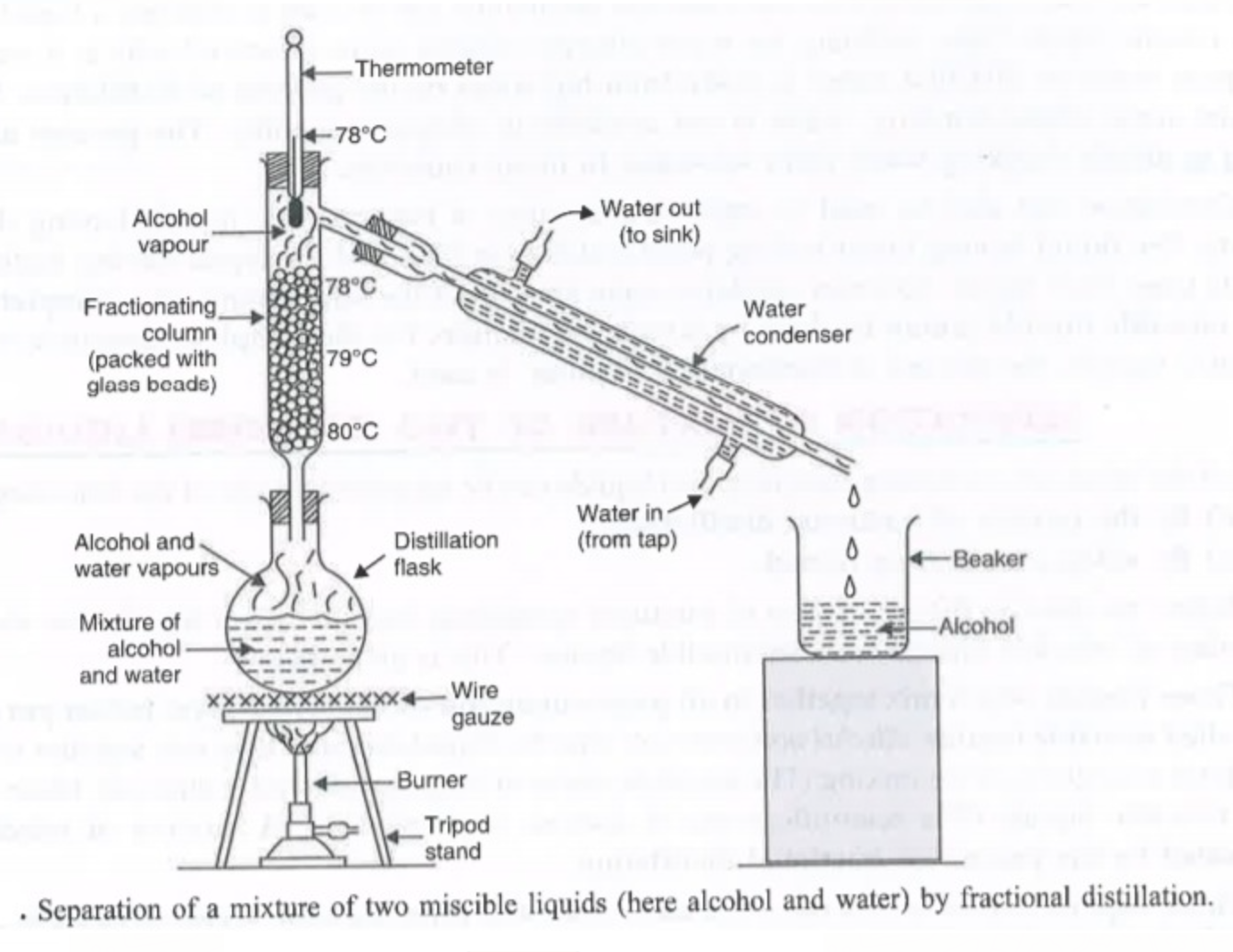
Iss same technique ko hum different gases from air, different fractions from petroleum products, mixture of chloroform aur benzene ko separate karne ke liye b use karte h.
Separation of Different Gases from Air
Ab air homogeneous mixture h aur iske components ko hum fractional distillation se separate kar sakte h. Iss process ko hum following flow chart se study karte h:

(a) Sabse pehle air ko hum dust, carbon dioxide, water vapour aur other unnecessary particles se filter karte h, kyunki agar water vapour aur carbon dioxide remove nahi hote h toh ye cooling process meh solid formation ki wajah se pipes ko block kar dete h.
(b) Ab jab hum pressure ko increase karte h tab air compress ho kar cool ho jati h. Then iss cooled air ko hum jet ke through ek chamber meh expand karte h. Ab iss expansion ki wajah se air jyada cool ho jati h.
(c) Ab jab process of compression, cooling aur rapid expansion of air baar baar repeat hota h tab ye air ko more cool karta h. Ultimately, air itni jyada cool ho jati h that it turns into a liquid aur iss tarah hum liquid air ko obtain kar sakte h.
(d) Ab iss liquid air ko hum tall fractional distillation column meh lete h aur isse slowly warm karte h. Jisme
(i) Jin gases ka lowest boiling point hota h jaise liquid nitrogen (−196∘C) pehle boil hone ki wajah se nitrogen gas form karti h, jisse hum top of the distillation column se collect kar sakte h.
(ii) Ab liquid argon (−186∘C) ka boiling point slightly higher hota h in comparison liquid nitrogen, so liquid nitrogen ke baad liquid argon boil hota h jo argon gas form karti h jisse hum middle part of distillation column se collect kar lete h.
(iii) Further, liquid oxygen (−183∘C) ka boiling point inn tenno meh highest hota h, iss wajah se ye sabse last meh boil hota h aur isse hum bottom of the distillation column se as oxygen gas collect karte h.
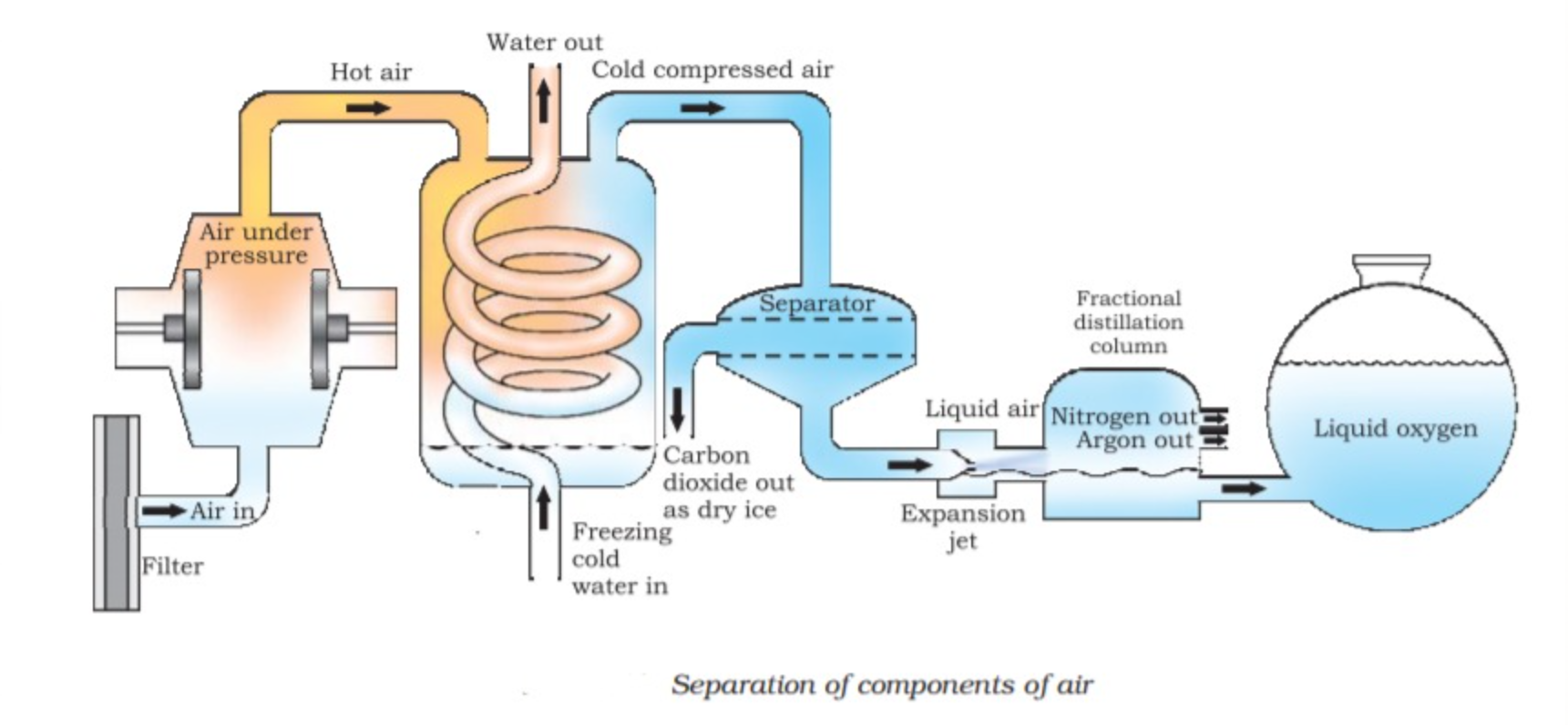
(ii) Separation by a Separating Funnel
Iss method se hum mixture of two immiscible liquids ko separate kar sakte h. For example oil aur water jab ye heterogeneous mixture form karte h.
Inn heterogeneous mixture ke individual components ko hum separating funnel use kar separate karte h, in which two liquids are allowed to stand aur tab yahan density ke basis par separate layers form hoti h. For example
(a) Sabse pehle hum kerosene oil aur water ko separating funnel meh pour karte h.
(b) Ab hum isse kuch time ke liye undisturbed rakhte h, so that oil aur water ki separate layers form ho jaye. Since kerosene oil ki lower density hoti h as compare to water iss wajah se ye upper part of the funnel meh present hota h whereas water lower side meh present hota h.
(c) Ab hum separating funnel ki stopcock ko open karte h aur lower layer of water ko carefully pour karte h.
(d) Later jab oil stop cock ke level par pahunch jata h tab hum separating funnel ki stopcock ko close kar dete h. Further separating layer meh jo kerosene oil rah jata h usse hum separate beaker meh lete by opening the stop cock again.
Note: Oil aur water ka separating funnel se separation 2 major properties par based hota h:
(a) Oil aur water ki densities different hoti h.
(b) Ye dono liquids immiscible liquids hote h.
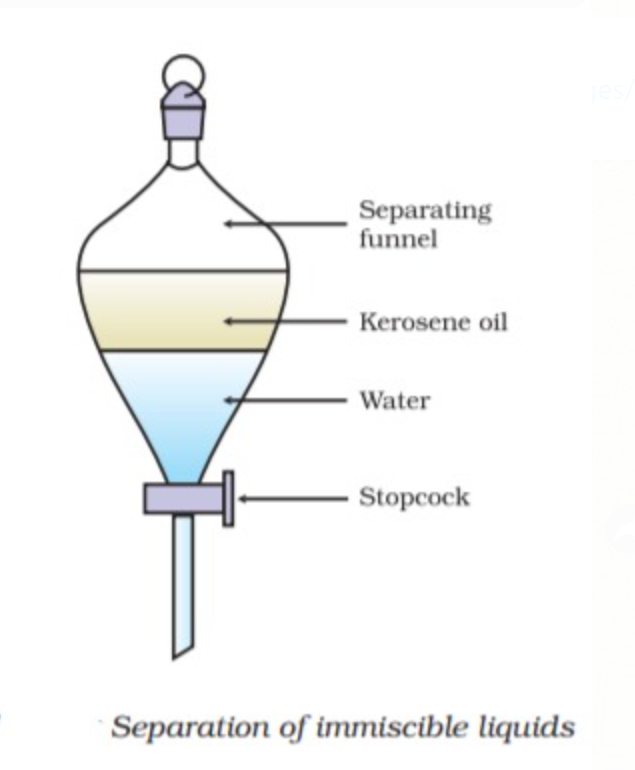
Further mixture of petrol aur water, groundnut/mustard oil with water ko b hum iss method se separate kar sakte h aur kyunki water heavier hota h iss wajah se dono cases meh ye lower layer form karta h.
Also mixture of sand, water aur mustard oil ko b hum iss method se separate kar sakte h.
Ab iss heterogeneous mixture se different components ka separation following steps meh hota h:
Step 1 : Sabse pehle hum mixture ko glass funnel se filter karte h. Isme water aur mustard oil ko hum filtrate ki form meh collect kar lete h while sand particles filter paper par as residue rah jate h.
Step 2 : Ab hum mixture of water aur mustard oil ko separating funnel meh transfer karte h aur jaise pehle humne discuss kiya tha waise hi yahan proceed karte h. Ab yahan b water separating funnel meh lower layer form karta h kyunki iski density high hoti h while mustard oil ki low density hoti h iss wajah se ye upper layer form karta h. As a result, two layers separate ho jati h. Jisse hum one by one separate beakers meh collect kar lete h.
3) Mixture of Two Liquids
All the mixtures containing two liquid substances can be separated by one of the following methods :
(i) Separation by Fractional Distillation
Fractional Distillation is the process of separating two or more miscible liquids by distillation, the distillate being collected in fractions boiling at different temperatures. The process of fractional distillation is used for those miscible liquids in which the boiling points are very close to one another that is less than 25∘C.
We cannot use simple distillation process for such liquids because in this the boiling point of the more volatile liquid is very close to the less volatile liquid so as a result both the liquid will distill together and separation will not be achieved.
Fractional distillation is different from simple distillation as it involves repeated distillation and condensation. Fractional distillation is carried out using a fractionating column which has long tube and beads at the bottom, the actual purpose of fractionating column is to provide different temperature zones, the highest temperature is at the bottom and lowest is at near the top of column, it increase the cooling surface area and provides obstruction to the ascending vapour and descending liquid.
To Separate the Mixture of Alcohol and Water
Alcohol and water are miscible liquids. The boiling point of alcohol is 78∘C and the boiling point of water is 100∘C the difference between both of them is less than 25∘C hence a mixture of alcohol and water can be separated by fractional distillation only.
(a) The mixture of alcohol and water is heated together in a distillation glass which is fitted with a fractionating column.
(b) When the mixture is heated both alcohol and water start to form vapour as their boiling points approach.
The alcohol vapour and water vapour rise up in the fractionating column, as the upper part of the fractionating column is cooler due to this when the hot vapours that rise up in the column, get cooled, condensed and flow back into the distillation flask.
(c) As the experiment goes on the fractionating column warms up by the heat released by the condensed vapours. After sometime a temperature difference is created in the fractionating column as the top temperature is lower than the bottom.
(d) When the temperature at the top of the fractionating column reaches about 78∘C which is the boiling point of alcohol then the alcohol vapour passes into the condenser gets cool and then collects in a beaker which is at the other side of the condenser.
The alcohol water mixture is kept boiling at same rate and repeated condensation and evaporation takes place till both the Miscible liquids are separated. After completion of alcohol distillation, we increase the temperature at the top of fractionating column to 100∘C then water is also distilled similar to alcohol.

The same technique can be used to separate different gases from air, different fractions from petroleum products, mixture of chloroform and benzene.
Separation of Different Gases from Air
Air is a homogeneous mixture and can be separated into its components by fractional distillation. The process can be understood by the help of following flow chart:

(a) Air is initially filtered to remove dust, carbon dioxide, water vapours and other unnecessary particles from it to prevent the blocking of pipes as they get solidified during the process if they are not removed earlier.
(b) The air is compressed by increasing the pressure and then cooled. This cooled air is expanded into a chamber through a jet. This expansion cools the air even more.
(c) The process of compression, cooling and rapid expansion of air is repeated again and again making the air more cool. Ultimately the air gets so cold that it turns into a liquid and in this way liquid air is obtained.
(d) This liquid air is then taken into a tall fractional distillation column and warmed up slowly. Then
(i) The gases having the lowest boiling point such as liquid nitrogen (−196∘C) boils first to form Nitrogen gas and is collected at the top of the Distillation column.
(ii) Liquid Argon (−186∘C) has a slightly higher boiling point than liquid nitrogen so it boils off next and gets collected as argon gas at the middle of distillation column.
(iii) Liquid oxygen (−183∘C) has a higher boiling point in comparison to other two hence, it boils off at last and gets collected as Oxygen gas at the bottom of the distillation column.

(ii) Separation by a Separating Funnel
By this method we can separate a mixture of two immiscible liquids. For example Oil and water when they form a heterogeneous mixture.
The individual components of such heterogeneous mixture can be separated by using a separating funnel in which the two liquids are allowed to stand and they separate out into separate layers depending upon their density. For example
(a) Pour the mixture of kerosene oil and water in a separating funnel.
(b) Let it stand undisturbed for sometime so that separate layers of oil and water are formed and as kerosene oil has lower density than water it is present in the upper part of the funnel whereas water is on the lower side.
(c) Open the stopcock of the separating funnel and pour out the lower layer of water carefully.
(d) Close the stopcock of the separating funnel as the oil reaches the stop-cock. Further the kerosene oil which is left in separating funnel can be removed in a separate beaker by opening the stop cock again.
Note: The separation of oil and water by the separating funnel is based on two major properties-
(a) The densities of oil and water are different.
(b) They both are immiscible liquids.

A mixture of petrol and water, groundnut/mustard oil with water can also be separated by this method and water being heavier forms the lower layer in both the cases.
Its application involves separation of a mixture of sand, water and mustard oil.
The separation of the components from this heterogeneous mixture can be done in the following steps:
Step 1 : Filter the mixture through a glass funnel. Water and mustard oil will be collected as filtrate while sand particles will remain on the filter paper as residue.
Step 2 : Now transfer the mixture of water and mustard oil to a separating funnel and proceed as discussed in section. Water will form the lower layer in the funnel due to high density while mustard oil form the upper layer due to low density. Now two layers are separated which is collected one by one in separate beaker by opening the stop cock.
SUMMARY
(1) A mixture contains more than one substance (element and/or compound) mixed in any proportion.
(2) Mixtures can be separated into pure substances using appropriate separation techniques.
(3) A solution is a homogeneous mixture of two or more substances. The major component of a solution is called the solvent, and the minor is called the solute.
(4) The concentration of a solution is the amount of solute present per unit volume or per unit mass of the solution.
(5) Materials that are insoluble in a solvent and have particles that are visible to naked eyes, form a suspension. A suspension is a heterogeneous mixture.
(6) Colloids are heterogeneous mixtures in which the particle size is too small to be seen with the naked eye, but is big enough to scatter light. Colloids are useful in industry and daily life. The particles are called the dispersed phase and the medium in which they are distributed is called the dispersion medium.
(7) Pure substances can be elements or compounds. An element is a form of matter that cannot be broken down by chemical reactions into simpler substances. A compound is a substance composed of two or more different types of elements, chemically combined in a fixed proportion.
(8) Properties of a compound are different from its constituent elements, whereas a mixture shows the properties of its constituting elements or compounds.